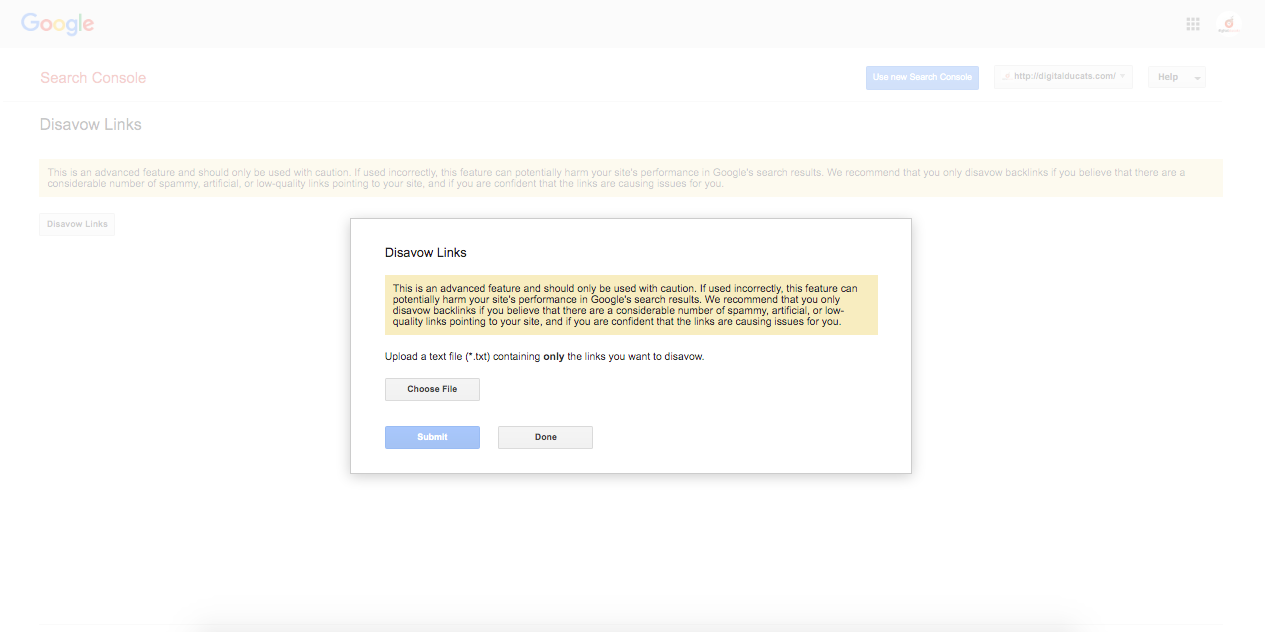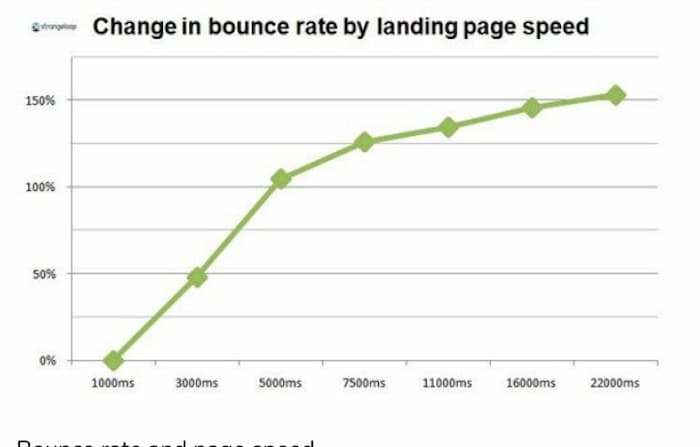Marketing Strategies To Increase Your Customer Base
Of all the marketing strategies to increase your customer base, there’s no doubt that inbound marketing has a major impact on the number of clients you receive from your website. Maximize the traffic your site receives by continually improving your website’s performance and adding additional sources of traffic.
Optimize for performance
There are hundreds of things to consider when you’re trying to rank your website. Running a site audit will uncover errors and performance issues that you can correct to make your site rank higher in the search results.
The ranking algorithm accounts for hundreds of factors in the overall placement of your website. It’s not just the large and blatant errors that will drag your websites ranking down. If your site errors only account for a small percentage of the performance of your site, correcting a large number of them can move the needle in your site’s ranking.
Improve site speed
The significance of the time it takes to load your pages can vary across industries. The retail industry is an example where site speed can play a direct role in the ranking of your website. A faster load time results in a reduced bounce rate, which on the first page of results is a metric that Rankbrain measures as a ranking factor.
The recommended time to load a page is around three seconds to get the first meaningful content on your screen. Many industry averages are still nowhere near the three-second mark. This presents an opportunity for a competitive advantage that results in an improvement in ranking.
Duplicate content
Search engines absolutely hate duplicate content. There are penalties dedicated to reducing ranking for any type of content that is copied or repeated on your site.
The main concern is plagiarism but because the penalty is algorithmic, any canonical errors will trigger a Panda penalty. If one of your articles is being displayed on more than one of your pages without a canonical tag it will count adversely against your website.
Thin content
The Panda update was initiated to address poor quality content. It targeted sites that had duplicate content, spun content and thin content. If your pages fall under any of those three possibilities, Google has penalized your site through an algorithmic filter and you’re suffering a demotion in the ranking.
It would benefit your site to update poor performing pages with more content to boost traffic. If the pages are not salvageable it would make your website more streamlined to delete them altogether.
Make video a regular part of your content
Over 87% of marketers would agree that using video is one of the marketing strategies to increase your customer base. The use of video increases the length of time visitors spend on your site. Increasing the average time on site is considered a ranking factor because it shows the level of engagement between visitors and your content.
Using video allows you to build a channel, subscribers and generate another stream of traffic from YouTube. Since 2017 video has experienced exponential growth in the number of shares, and the number of YouTube users creating a massive traffic opportunity from the number of searches performed daily.
YouTube is officially the second most popular website in the world, recently surpassing Facebook who formerly held the #2 position. People will search YouTube for product reviews and find out how to learn a skill or accomplish a task. By optimizing your videos on YouTube you drive traffic from a completely separate search engine to supplement your overall monthly traffic.
Capitalize on features being displayed on the first page of results
The emergence of SERP features (search engine results page) has been a controversial occurrence that Google has implemented over the years.
These Google products (ads, local listings, featured snippets, etc.) have steadily chipped away at the available traffic to organic search results by absorbing the available clicks. Your company can increase its customer base by optimizing the appropriate feature.
The features that appear in the SERP entirely depend on the search intent behind the keyword being typed. If a user searches for a product, the SERP feature that appears could be a product carousel of ads, a list of Google Ads, local listings and in most cases a People Also Ask Box. If a user types in an informational query it could trigger a featured snippet, knowledge panel and PAA box.
Companies can benefit from the different streams of traffic from each of these Google features, however, each requires a separate method of SEO to be featured in the top positions.
The featured snippet is a Google product in which your website can compete if it currently ranks within the top 10 results on the first page. By optimizing the HTML for the snippet that exists you can win the snippet position as well as be listed in the organic results. The snippet represents approximately an 8% gain in the volume of traffic your site receives.
The Local Finder is an additional source of traffic that can provide high converting visitors to your site. The finder will list the companies that operate within your city and display the company information you provide in your Google My Business profile.
By optimizing your website for localized search results you can not only place your business in the organic results but in the local pack as well. The additional position on the first page of results can make a significant difference in the quality of leads your company receives.
The PAA boxes are also a good source of additional traffic. To appear in the PAA boxes your content should be optimized to answer questions that are currently being displayed in your keyword search.
Increase your client base
A top position on the first page of organic search results is definitely the goal for your company. Improve the performance of your site to continue your upward climb to the top of the first page. No matter how small the improvements, nothing is too insignificant when every jump in ranking will increase the traffic your website receives.
Take advantage of every opportunity to implement effective marketing strategies to increase your customer base and provide more revenue for your company.
10 Common SEO Mistakes To Avoid
Oct 23, 2023 @ 7:27 amSEO requires addressing. many moving parts to get your website to rank on the first page of Google. Not only do you need to account for the most influential ranking factors, but you also have to publish pages to outperform your competition. As you work towards these objectives it’s imperative to avoid these 10 common SEO mistakes that could cost you time and money to correct.
No-indexing a page
Whenever you publish a page on your site, search engines need to index the page and make it available in a search result. A “noindex” command will tell search engines to ignore the page completely and exclude if from its index.
If you’re publishing content frequently or have granted multiple user access, it’s one of the common SEO mistakes to accidentally mark the page noindex in the settings or in the HTML editor.

You can check to see which pages are marked “noindex” by entering your URL in the dashboard Deepcrawl.com
This tool will crawl your site and report the errors your website is generating as well as report all of your pages marked noindex.
Failing to submit a sitemap
A sitemap is a list of all the pages that have been published on your website. Think of it as a blueprint search engines use to confirm the pages your site has on its index. Without a sitemap, you risk that your pages will not be indexed without any links pointing to the domain.
Search engine spiders find new content through a sitemap or by crawling webpages and following links on the pages to new pages. If you don’t have any internal or external links to your pages, you need to include those pages on a sitemap or they will never appear on Google-or any other search engine index.
To avoid this potential disaster, go to the Search Console and click on the sitemaps tab. You can submit your sitemap directly to Google to make sure it has all of your pages on their index.
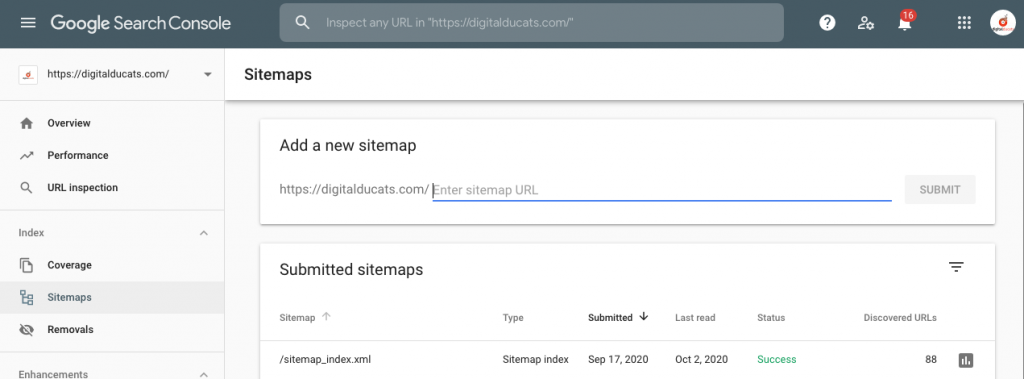
Missing a canonical tag
If there’s one thing that will immediately get your website penalized-it’s duplicate content. This could get your website sandboxed however you can easily correct the situation and recover your ranking by deleting the duplicate pages.
The second option for posting content that isn’t original is to add a canonical tag:
<link rel=”canonical” href=https://originaldomain.com />
Place this tag on the page that would be considered duplicate content and it communicates to search engines where the original document exists.
Paying for links
It is against Google’s best practices to engage in any link-building scheme that manipulates ranking. Any website that is exposed to being in a paid link transaction will suffer a penalty that will reduce ranking, traffic and overall search visibility.
If you make the mistake of buying links from a website that gets exposed for selling links-both the site selling links and everyone linked to it will be penalized. Google has come down hard on sites that sell links and everyone involved.
Ask for the links to be removed or nofollowed immediately. If you don’t get the website to respond, your last option is to use the disavow links tool.

Overusing anchor text links
There was a time where your ranking improved by acquiring more backlinks with the keyword as anchor text This practice is no longer effective and when done in excess will trigger an algorithmic filter (commonly referred to as a Google penalty).
Use anchor text sparingly, whether you’re linking from within your site or from a referring domain. Too many anchor text links and your site will be deemed over-optimized and banished to the Google sandbox for that specific keyword. Keep in mind that little to no use of your anchor text may leave your page under-optimized.
Balancing your off-page and on-page optimization is a skilled practice that requires strategy back by analytical research of the what’s working for the top ranking websites for your keyword.
Not targeting a keyword
It shouldn’t come as surprise when your page doesn’t rank if you haven’t optimized for a keyword. When you’re publishing content you should target a keyword by improving your on-page optimization to target specific keywords(s).
Choose a target keyword and place it in the expected places on your page that enhance optimization such as the title, URL, within the first paragraph and in your image alt tags.
Your on-page optimization will help to clue search engines in on the keyword you want your content to appear for in the search results.
Choosing the same keyword on multiple pages
If two pages are optimized for the same keyword they compete with each other and search engines will more often than not rank both pages lower than what they could be ranked. This is known as keyword cannibalization.
Optimize every page on your website for completely different keywords. If you have separate pages that target the same keyword you can opt to consolidate the content from both pages on the top-performing page (the page with more backlinks and more traffic).
If you choose this option, you will need to redirect the URL that you’re deleting to indicate where the content has moved. This change to your website should get you a boost in ranking and an increase in traffic to the existing page.
Unnatural link building
Avoid unnatural link building, such as building too many anchor text links from the same website. Any time links that are deemed unnatural by Google it results in the loss of your ranking. According to Google’s best practice guidelines, links are supposed to be acquired organically, naturally and but without the intent to manipulate ranking.
If a brand new website that has been around for a month suddenly gains 10,000 backlinks, it’s going to raise some red flags.
Keep your link building looking natural to avoid any further scrutiny on your site.
Not sharing your content
If you haven’t built links or ways for people to find your content, your page won’t get any traffic and will never rank highly. When you publish content, get it in front of as many eyes as possible so it can be shared, linked and rise in ranking to drive additional traffic.
Post your content to your social media network for an injection of traffic to your site. The added boost of people can start the ball rolling if people are sharing and linking back to it.
You can also build links to your page to improve the ranking and ultimately the traffic it receives. The additional backlinks will improve the page authority, ass more ranking ability and create more entry points to your website.
Inability to satisfy search intent
Search engines will look for the best websites to display on their first page of results. One of the main reasons a page will rank is found in its ability to satisfy search intent. Failing to do so is one of the worst common SEO mistakes to make.
If you can keep a user on your page and your page ends their search, you have effectively satisfied search intent. If your content is thin and lacking information, your site will not rank highly because of its inability to satisfy search intent.
Identifying the true intent of a user can be logically deduced as well as researched to explore a wide range of options. Keyword research provides many clues to the related topics users will be searching, along with your keyword.
By identifying the topics and subtopics that the user will naturally be interested in you cover a wide base of intent. You can demonstrate this ability by publishing and linking related content on your website to form topic clusters. This is a basic model for creating depth in your topic and ranking highly for your main keyword topic.
Avoid common SEO mistakes to make a first-page appearance
Considering the sophistication of search engines it always helps to get started in the right direction by accounting for the most important ranking factors. Learn from the common SEO mistakes that have been made by many and build your site a permanent residence on the first page of Google.
What’s The Difference Between SEO and PPC?
The difference between SEO and PPC is that search engine optimization is used to improve your position in the organic search results to receive unlimited free traffic, whereas PPC is paying Google for a designated spot on the first page and you pay for every click made to your website.
There are so many options to advertise your business online that knowing which way to go about it requires having clearly defined goals in order to develop the best strategy for your company. One major decision your company may be considering is whether to use paid advertisements or invest in search engine optimization.
On one hand, you have a paid version that puts you on the first page of Google immediately. On the other hand, you have a major portion of traffic that heads to the organic results. Which one is the right option for your company?
Related reading: 7 Tactics To Improve Your Pay Per Click Marketing Strategy
What are the organic search results?
The organic results are all of the websites listed as Google’s top choices, which they base primarily on a website’s ability to answer search intent. Websites compete with one another trying to earn the highest-ranked position in the organic results.
Investing in SEO improves the quality of your content, website optimization and increases backlinks to improve your website’s ability to rank. The organic results are everything that’s not a paid result or a Google SERP feature (local listings, featured snippet, knowledge panel, etc.)
What are the paid results?
The paid results are usually the first listings in a search result at the top of the page that is labelled “Ad” to the left of the URL. To be placed in this position companies will set up a PPC campaign (pay-per-click) and whenever a user clicks on the listing they pay a fee for a person to visit their site.
How much does PPC cost?
The CPC (cost-per-click) is determined through a bidding system. Your campaign is set up to pay within a certain range for every click made to your site. You determine the maximum amount you are willing to pay for each click.
If the keyword that you’re bidding on is making people money, the CPC will be driven up higher because people are willing to pay more for keywords with high commercial value.
It’s not uncommon to see CPC’s of $80 per click in the bail bonds industry due to the nature of the business. For keywords like “fidget spinners,” you could expect something less than a $1 per click.
PPC campaigns can be capped at a monthly limit of your choice. If your budget only allows $1000 a month then you will as many clicks as $1000 affords. If your keywords are $20/click you will only get 50 clicks to your website for the month.
How much does organic traffic cost?
Optimizing for organic search results represents a different approach to generating traffic. The initial cost per visitor starts higher because of the investment required to rank your site.
Let’s assume the average cost of SEO is $1000/month for one keyword and the average time it takes to see results in 6 months.
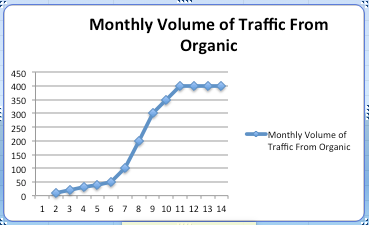
This means that by each month your cost per visitor start to declines as the volume of your site is increasing.
Advantages of organic traffic
- On average, 1 out of 10 blog posts are compounding posts. That means that the older the post gets the more links, the more shares, the more traffic it builds over time. (~Hubspot)
- The cost per visitor is constantly being reduced with the increase in traffic
- Organic traffic accounts for 60% of desktop searches and 40% of mobile searches so there are more available clicks to your site
- 33% of people will recognize paid ads and purposely skip over the ads to the organic results.
- Ranking your site organically increases your digital footprint within your industry and improves brand recognition
- A strong organic presence will influence the frequency of appearances in localized searches.
- Higher conversion rates from organic results
- People research companies from the organic results
- Traffic continues well after you stop SEO services
Advantages of PPC campaigns
- Puts your site on the first page immediately
- Places your listing at the top of search results
- Immune to Google updates
- Mobile search results have a growing click-through rate
- Mobile has a growing percentage of conversions
Conclusion
There’s no doubt that both strategies to drive traffic are able to increase the revenue your site produces.
If your strategy demands quick short-term results, a PPC campaign can provide that solution at a higher price than what you would pay for organic traffic.
If you’re interested in making more money in the long term, organic SEO has the potential to drive higher volumes of traffic at a much lower price.
For long-lasting results and high volumes of traffic that continues flow to your site even after you stop paying, choose SEO. Invest in the development of your website to appear in the organic results to receive a higher return on your investment.
What Are Featured Snippets & How Do You Get Them?
Oct 23, 2023 @ 7:27 amFeatured snippets are Google’s way of delivering what it perceives to be the most accurate response to a search query. Most would consider the featured snippet an improvement in user experience because it directly answers a search query with highlighted information.
Some consider it a negative feature because it provides the information a user wants directly on the result page resulting in a lower click-through rate to your website.
While in any given circumstance, both beliefs are true, the majority of snippets have proven to increase traffic rather than keep it on the SERP.
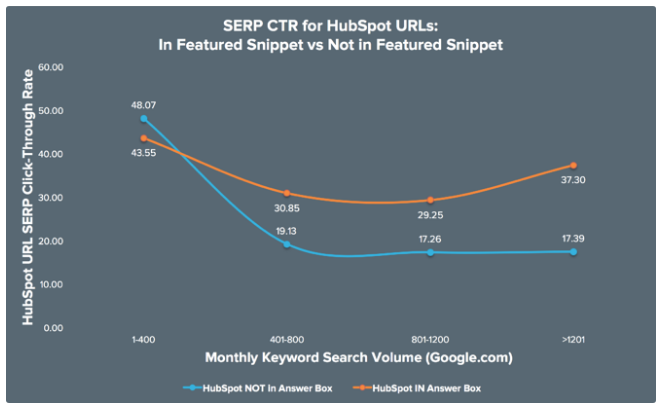
In 99% of all instances when the featured snippet is triggered in a search result, it appears at the top of the page. Since it appears ahead of the organic results, marketers often refer to the featured snippet as Position Zero.
Recently, Position Zero became the new number one organic listing on the SERP (although it is still referred to as position zero). The old version of snippets allowed a website to win position zero as well as have a position as a blue link in the organic results.
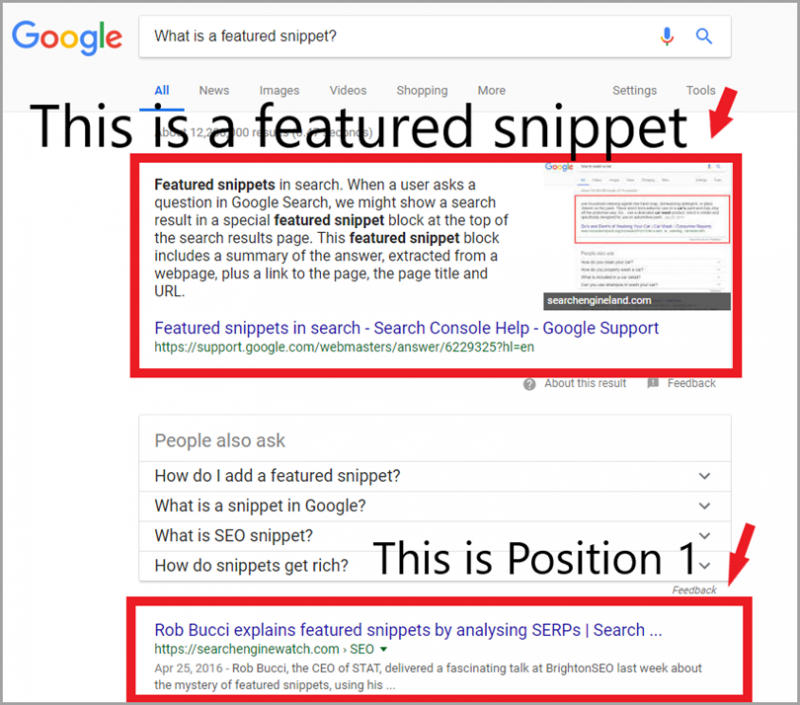
Now, the featured snippet repositions your website position from the organic results with traditional blue links to the top position as an enhanced search result (referred to as a rich result).
What are the advantages of a featured snippet?
Your listing holds the top SERP position
The featured snippet is a coveted position because of its prime location. Your website receives the highest click-through rate and therefore the most traffic from winning the position. This is especially dominant on mobile screens, where the feature takes up most of the screen.

Your search listing becomes and enticing, attractive rich result
What’s more, your website is featured as a rich result. The added markup to displaying your page makes for a more attractive search engine listing. Look at how much more your attention this feature demands compared to the organic blue links.
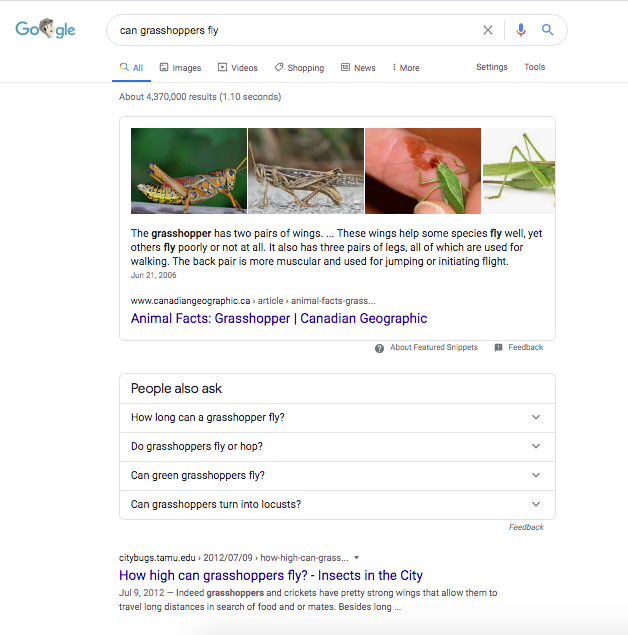
The featured snippet is considered to brand your website as an expert since Google is featuring you as the top result. This is something that no other feature can do for you regardless if you pay or not.
Organic results are the most trusted in comparison to paid results and so acquiring this position is a major benefit to branding your company as an authority in your niche.
Increased likliehood of being selected for a voice search result
Voice search and featured snippets are linked because the results from voice are often displayed from featured snippets.
In fact, 80% of Google home results are pulled directly from featured snippets. Snippets are considered to be the best answer to a search query, so it makes sense that they would be the first choice in a voice search. The use of structured data also makes it easy for voice assistants to pull information quickly and provide quick and accurate answers.
The different types of snippets
There are four major types of featured snippets that have become regular features on the SERP.
The most common is the paragraph snippet that is seen in approximately 70% of all featured snippets.
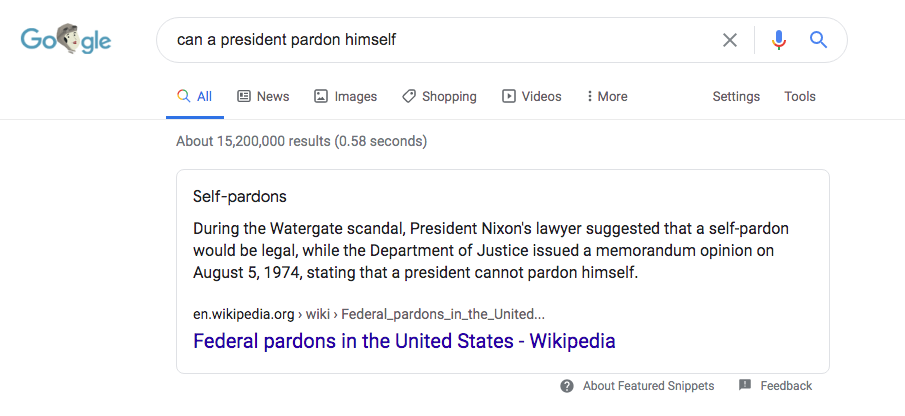
The list snippet is the second most common type and accounts for 19.1% of all snippets:
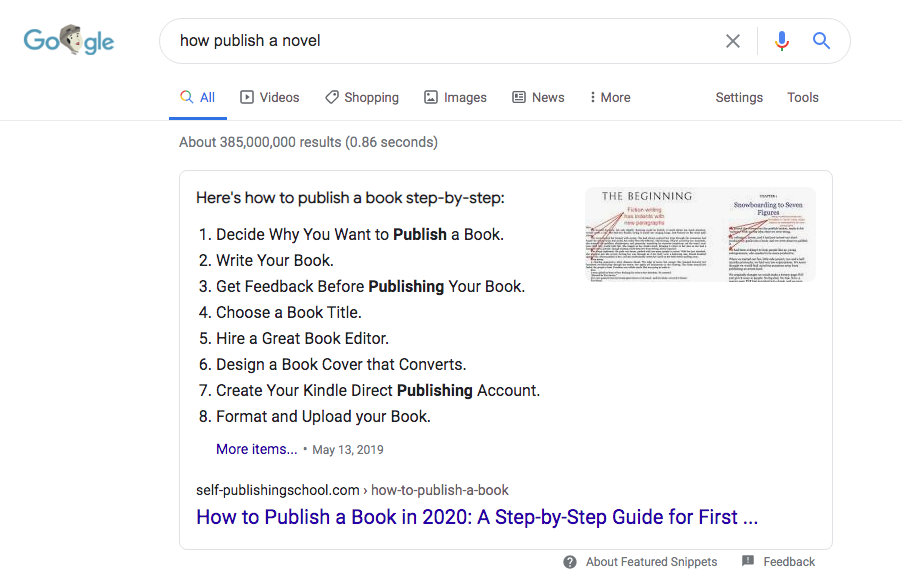
Table snippets account for roughly 6.3%
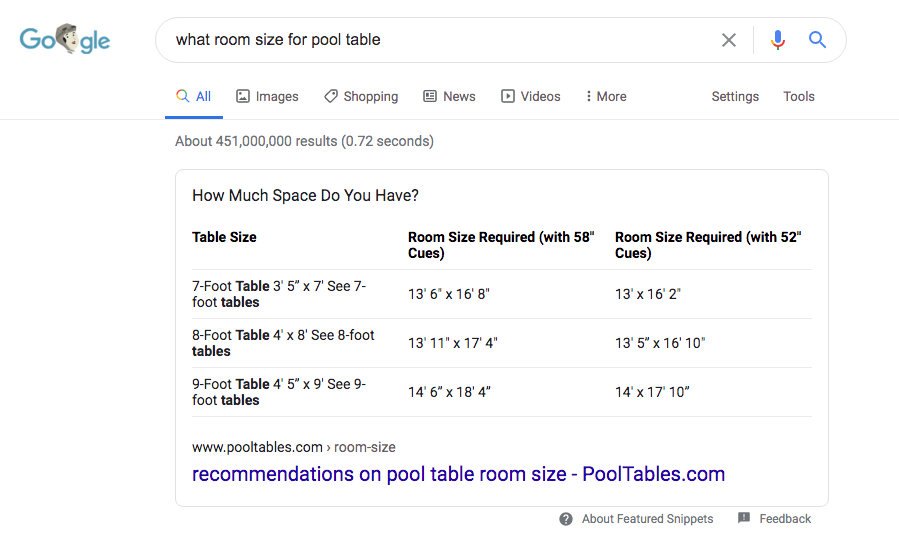
And videos have slowly been gaining ground, but are still only around 4.6% of all featured snippets.
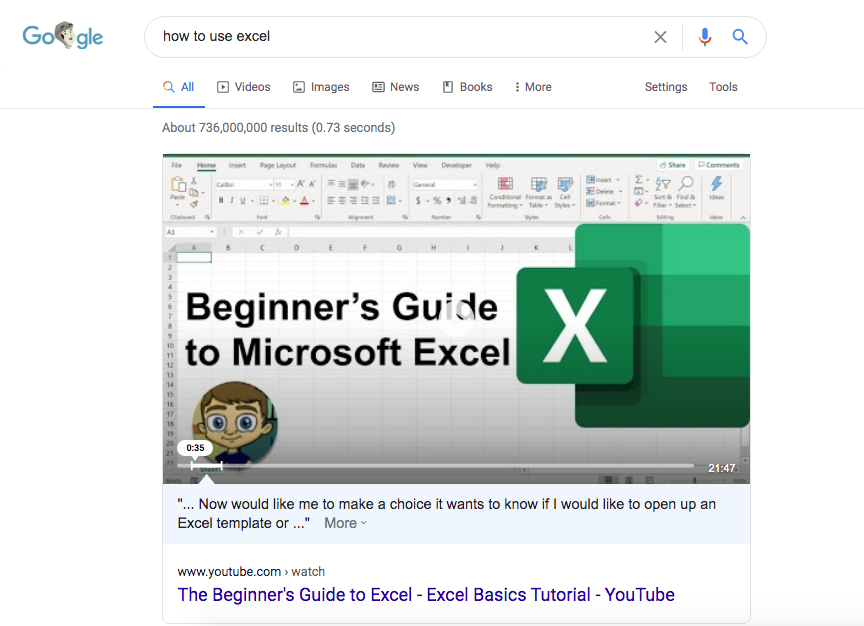
How do you win position zero?
A function of SEO content writing is to make content “snippable.” It helps to know whether a snippet appears for the keywords you’re targeting. The most common searches that trigger a snippet are searches that begin with can, how, what, who, when, why.
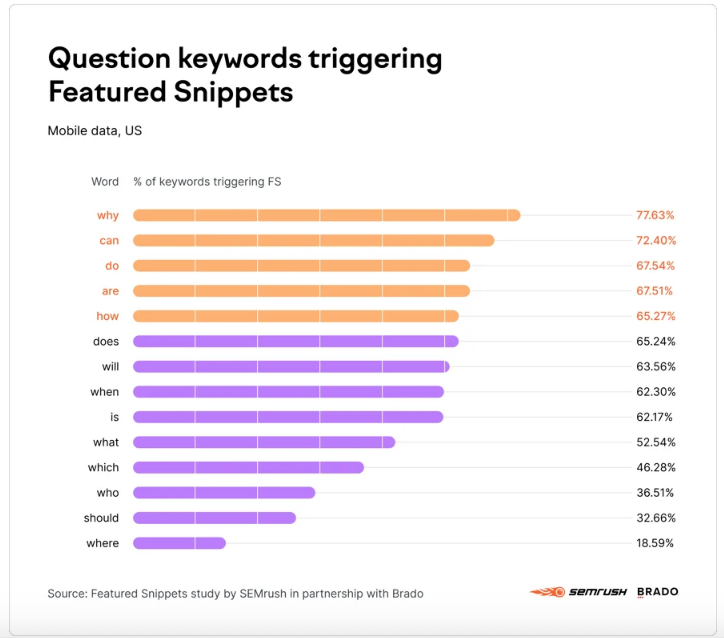
Rather than search manually for every possibility, it’s best to use software to streamline your efforts when researching keywords. When you’re assessing the potential of a keyword you can see what features appear on the SERP and make sure your content is optimized to appear for the question.
Another way to go about identifying opportunities is to search the keywords in which your website holds a position in the top 10 results. You can then toggle the filter to show which of those search terms display a featured snippet on the SERP.
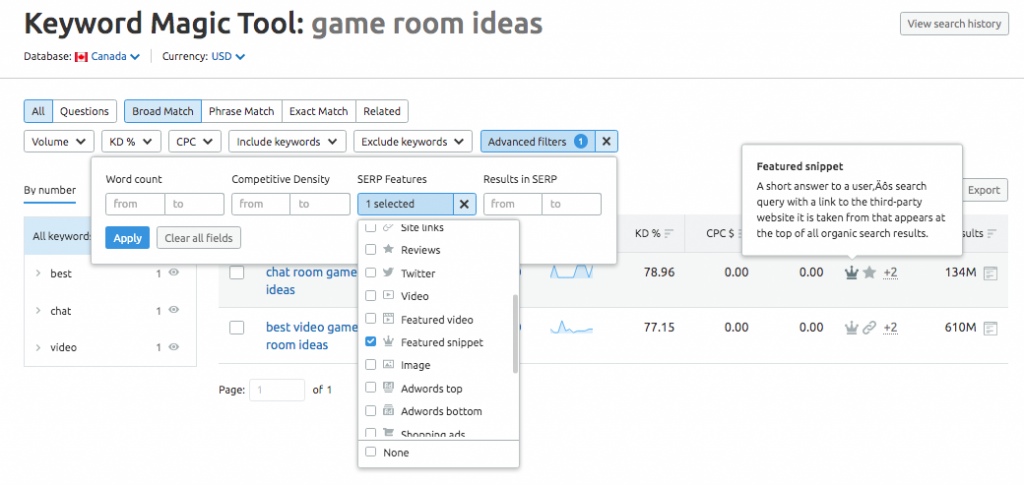
Analyze the current snippet holders content
Although no one has the exact recipe for how Google decides what website to place as the featured snippet, the best practice is to include the major characteristics common among snippet holders.
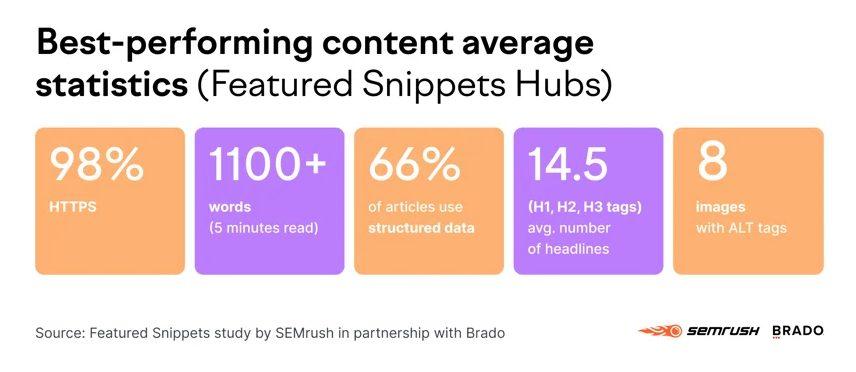
Secure Socket Layer
It should be a given that your website uses HTTPS. If you haven’t got onboard yet, you’re way behind. Google has made it clear that HTTPS offers a slight ranking advantage over HTTP. Regardless of search engines, consider the fact that users don’t want to visit a website that is marked as “not secure.”
Chrome labels domains not secure whenever the SSL certificate is missing. In order to get to the site, you need to click on the advanced setting, and then click proceed to the website. This definitely plays a role in how users perceive your website and will contribute to higher bounce rates and a decrease in traffic.
Depth of content
The content on your page should have some substance to it. The depth of your content should be adequate enough to pass as authoritative. If you have a flimsy page with 200 words there’s no chance you could cover any topic in depth or detail. The average word count on pages with featured snippets are over 1100 words.
Title tags
Always use headings and subheadings to segment your content and highlight the most important aspects. This provides clarity to the content your page covers and is often used in snippets.
Tag your titles and subtitles in the proper hierarchy and if possible, provide a summary answer to your h1 title tag with the subsequent subheadings (h2-h6). The average number of headings on a page that has won the snippet is 14.
Images
The images that are featured in a snippet are not always taken from the page whose answer is being featured. Using images in your content gives your page context and enhances optimization. Let’s face it, content with more images is considered to provide a better user experience and therefore considered higher quality.
The average snippet holder has 8 images on their page with the alt tags completed.
Duplicate the optimization being used to win the feature
To win the snippet, you’ll need to understand what Google likes about the content that’s already being featured. Here are a few major characteristics that are common among the different types of snippets.
Paragraph snippets
A featured snippet in paragraph form is most commonly found to have between 40-50 words explaining the snippet question.
Tag your snippet question and provide the most detailed, comprehensive summary of the answer immediately following the heading.
Keep in mind that Google will use subtitles to form a paragraph in a featured snippet.
List snippets
Always analyze the snippet holders’ content to see the best way to optimize for the featured snippets. The list snippet can be won by using an ordered list but it can also be displayed as a collection of subtitles from your content.
The best practice is to create lists with 9 or more lines in order to increase the click-through rate to your website. There’s less incentive for a user to click-through to your website if a full list is displayed that answers their intent for the search.
Table snippets
Give your table a title and make sure you phrase the heading using your keyword. Tag the title using h-tags to highlight the questions your table can answer.
Video snippets
Use your snippet question in the title of the video. All YouTube videos are already marked with structured data, however, you should include a transcript of your video in the description. This gives search engines the exact content in the video (which is more than most people provide) creating a competitive ranking advantage.
Increase your traffic with the featured snippet
Featured snippets have become extremely common for answering questions directly on the SERP. Aim to improve the traffic your website receives by winning position zero when your content ranks in the top 10 search results.
The effect of branding your company as an authority combined with the additional traffic will be worth its rewards in new clients and increased revenue.
Want to get your site featured in position zero? Speak to a consultant about including featured snippets in your SEO service package for additional traffic to your website.
Scholarship Link Building Strategy
Scholarship link building is a widely practiced link strategy to acquire .edu links from schools and universities by offering an outside scholarship to students.
The strategy became extremely popular because of the success that websites were experiencing ranking for competitive terms from the links they received from universities.
Although some of the criteria have changed offering scholarships to schools and universities can be an excellent way to brand your business and acquire powerful links to your website.
What makes a quality backlink?
The best backlinks are those that come from trusted sites from within your niche. That’s it, bottom line. Preferably those sites will have high domain authority.
Domains that have a strong backlink profile will pass on more authority to your site than that which has a low domain authority.
Before search engines could determine the context of the content, a link from any high authority domain would improve the ranking of your site-no questions asked.
Today search engines are extremely efficient at establishing the relationship between pages that are linked making the relevance of your links a much stronger ranking signal.
Establish link relevance
To illustrate this further let’s use two websites as an example. The first is the iron chef’s blog with a DA of 83 and the second is a local web development company that has a new website with a DA of 23.
If you’re a software developer, the link from the newer company within your niche will count for more than from a cooking blog-no matter how juicy its metrics are. The relevance of the link is the most important aspect of link building.
When a link has no relevance to the content it points to search engines will assign low value, ignore it completely, or devalue your websites domain authority if there is obvious evidence of link manipulation.
Are all links are created equal?
There has been a long-standing assumption that .edu links hold more inherent value than a regular link. This dates back to a time before search engines had the ability to determine context. A .edu link was considered an incredibly powerful link because they are from schools and universities and were typically hard to come by.
John Mueller made a statement that busted the myth that .edu links were better than other top-level domains.
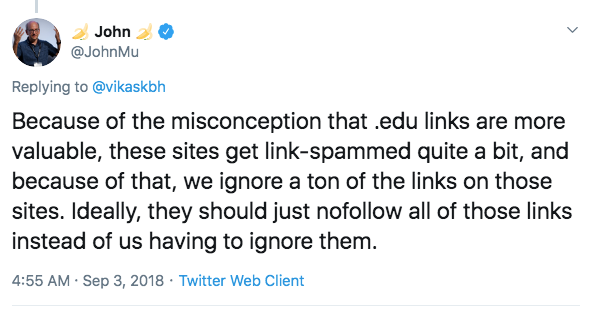
The underlying truth to this misconception of .edu links being higher quality wasn’t just because they were “.edu” but because they were from trusted websites. A link from a .edu was associated with great metrics.
Universities tend to have thousands of links and are high authority domains. Although the domain extension is not the reason, there are massive amounts of high-quality links in the education industry that will provide a competitive advantage because of great metrics.
Use scholarship link building to acquire high-quality backlinks
The strategy is to offer scholarships to universities who in return post your offer on their website with a link to your site. This tactic emerged when companies were able to successfully acquire .edu links for a reasonably cheap price. This tactic is still working to provide a safe and competitive link building strategy when it is from a site that will benefit your own.
The concept is simple. Your company offers a $1000 scholarship to a student. The scholarship is awarded to the winner of a competition for who can write the best essay for a topic in your niche.
How to make a scholarship offer
For example, if you were in the software business, a page would be built on your site specifically detailing your scholarship offer. The offer would be sent to schools that offered tech-related courses to compliment your industry. The offer might read like this:
“Software Tech believes that the best solution to living a good life is through secondary education. We are awarding a $1000 dollar scholarship to the student who writes the best essay for how accounting software is changing the way we do business.”
If a university accepts your offer, it will be listed on your site as an outside resource that provides financial assistance. You get a link from their page to your scholarship offer and your site receives a boost in ranking from a link related to your industry with great metrics.
Keep in mind that before you offer any school this offer, you will need to vet each website. The same rules apply to .edu sites just as they would to any other website that you would consider as a link opportunity.
For example, the number of outbound links that are on a page will affect the link quality. Pages that look like low-quality directories might be under fire and closely scrutinized by search engines so they would need to be avoided.
Scholarship link building is still an effective link building strategy
Finding quality school websites that will agree to a scholarship offer has become more difficult but there are still many link opportunities that exist that will add value to your backlink profile.
Scholarship link building can be used as a way to brand your business and create newsworthy information your company can use for press releases, which will provide additional links to your site.
When this strategy is executed according to the best practices, you acquire powerful backlinks that provide a competitive edge in the search results.
Related Reading: 9 Effective Backlinking Strategies FOr 2020
10 Alternative Traffic Sources To Google
Oct 23, 2023 @ 7:27 amImagine you fell from Google’s good graces. What then? Would your website be doomed to a life of mediocrity or are there alternative traffic sources you could use to bridge the gap?
Luckily for all of us, Google isn’t the only source of traffic for finding streams of interested visitors. It does however account for 86.86% of the global search traffic making it the largest source of traffic available.
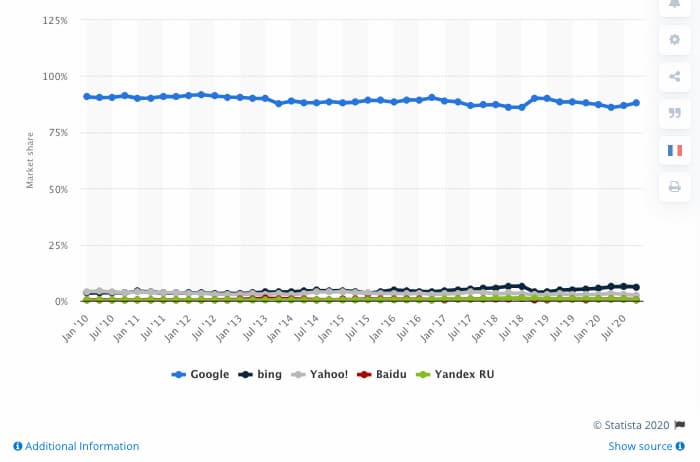
Can a business survive without tapping into Google at all?
When you take into account the options available, you may be surprised at how effective these alternative traffic sources are for driving high-converting visitors to your website.
#1-YouTube
Although it’s been a top choice as a marketing tool for many years, the momentum YouTube has gained in the last few years has been formidable. YouTube officially passed Facebook and is now the second most popular website in the world, with approximately 2 billion users.
YouTube is no longer just a way to supplement the traffic to your website, it’s now become an entire business model.
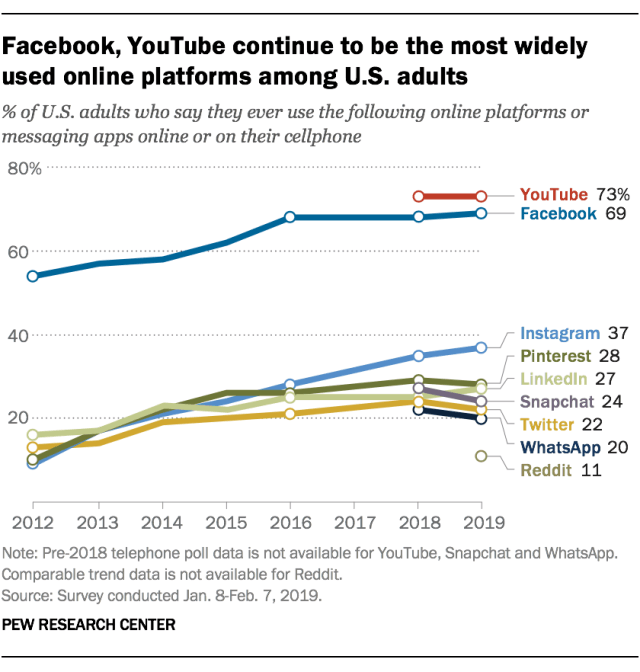
Image source: https://www.businessofapps.com/data/youtube-statistics/
Here are a few stats that prove the value of using YouTube for traffic:
- 96% of people between the ages of 19-24 use YouTube (~Statistica, 2018)
- Traditional TV is on the decline down 12% with 18-34 year-olds (~Marketing Charts, 2018)
- 1.9 Billion logged in users every month (~YouTube, 2019)
- During 2017-2018 people have watched over 50000 years of product review videos (~Think with Google, 2018)
Search engines are listing videos more frequently as the best solution to answering search intent. This presents opportunities in driving traffic from both Google search as well as YouTube.
The fact is that YouTube is being used as a search engine for people looking for “how-to” videos and product reviews. For many businesses, this aligns perfectly with building brand recognition and driving traffic with visitors who are already in the buyer’s journey. Tapping into this market to generate more leads is an option that cannot be ignored.
Most shared form of content
As the most shared form of content, videos can generate traffic from YouTube itself as well as be shared on multiple social platforms and websites.
This is a powerful quality for driving traffic and getting your content in front of a larger audience. If someone likes your video and shares it on their Facebook network, you’ve exponentially increased the reach your video has just from one person.
YouTube is a search engine itself
With over 2 billion users on YouTube, there is already plenty of traffic on-site that you can take advantage of. People go directly to YouTube to learn more about a brand, watch a product review or even just to learn how to do something.
The fact that there are fewer videos than web pages also makes ranking on YouTube considerably easier for a lot of keywords. You can optimize for non-competitive phrases and begin ranking for those terms in less than 24 hours.
How many words is a video worth?
If a picture is worth a thousand words, how many words is a video worth? The truth is many people prefer video to any other content type. There’s more descriptive value, brand recognition and users can digest a lot of information with less effort than reading.
Gen X and the Millennial generation have traditionally leaned towards watching videos as a personal preference. This should be enough for publishers to reconsider their marketing strategy when videos will continue to play a larger role in driving traffic and conversions.
#2-Influencer marketing
An influencer is a person who has the power to influence a large audience to make a purchase decision. By simply reviewing a product provides a company with added exposure to drive traffic. A mention on a video or social media post can lead thousands of curious followers to flock to a website. With power like this, influencers have become a viable option as a source of traffic and conversions.
To illustrate the power of influencers the royal family serves as a perfect example. When Prince William and Kate Middleton presented their baby to the public for the first time, the baby was wearing a swaddling blanket from Aden and Anais.
Neither Prince William nor Kate had any monetary motivation and didn’t mention the blanket and yet Aden and Annais went from 14k searches to 70k searches within a month. The increase in traffic was so sudden that it crashed their servers on several occasions.
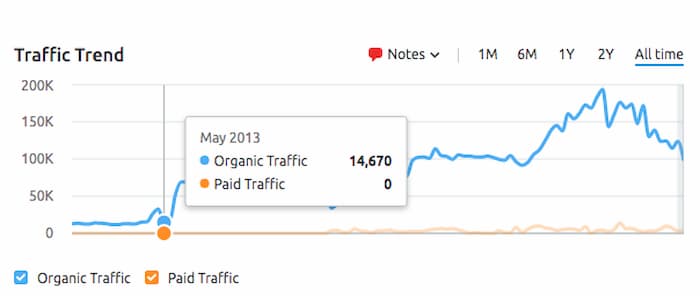
The one event with their product on a major influencer has made millions of dollars for the company Aden and Anais.
How to get mentioned by an influencer
For the most part, influencer marketing requires money in the budget to pay for a post or mention. Generally, the bigger the influencer, the more money they ask for since they have more people in their network.
Take a look at Dwayne “The Rock” Johnson’s followers sitting at 204 million. One mention from him could send your sales through the roof, however, it probably costs quite a lot to get your product in his hands and in front of his audience.

Approach micro-influencers
A more cost-effective strategy is to approach micro-influencers in your niche. A micro-influencer has around 10-15K followers and is a lot more accessible than a celebrity or major influencer. They also cost a lot less than those with hundreds of thousands or millions of followers.
Mention influencers in your content
It’s not always feasible to pay influencers for a mention but if you’re smart about your posts and strategically include them in your content, you’re more likely to get mentioned.
For example, Jetish Patil was able to get a mention on Twitter by simply quoting Robbie Richards and then tagging him in the tweet. Robbie happened to notice it and retweet his quote to his audience. Bam! Now he’s in front of Robbie Richards massive social network.
"Content marketing boils down to: knowing your ideal customer, where they hang out online, and what messages resonate with them at each stage of the funnel" – @RobbieRichMktg via @RealJoeEscobedo in #contentmarketing .https://t.co/V99GToMyOz#ContentMarketing pic.twitter.com/GaCskMBErg
— Jitesh Patil (@jiteshpatil) April 11, 2018
Measure the impact influencers have on your traffic
It’s important to have a way to measure and track the success of influencer marketing. It’s hard to know whether your success is directly coming from the influencer’s network without having a system in place for measuring results.
One way where you can save money on the cost and measure direct results is to pay Instagram influencers to publish a story on your company or product. An Instagram story only lasts 24 hours but if people swipe up they are taken directly to your website.
This approach can give you an excellent idea of the success of your campaign since it only runs 24 hours. Any additional traffic and conversions that you receive during that time can largely be accredited to the impact of your influencer.
#3-Guest post with a Personal Influencer Network (P.I.N.)
Guest blogging can land you some high-quality links on high traffic websites. This strategy alone is ideal for generating referral traffic when your content is being featured on websites that generate large volumes of traffic.
Combine guest posting with a team of partners to multiply your guest posting efforts and generate more traffic than if you were doing it all yourself.
The simplest approach is to reach out to the authors that have already been published on top sites in your niche. You want to make sure they’re publishing quality work on websites that have a good readership and are writing about topics directly related to your business.
The deal is to provide a mention for a mention. Keep track of the links you’re giving and receiving on a shared Google spreadsheet so you can monitor how much weight everyone is pulling in comparison to yourself.
With five people in your network, every article you publish is worth 6 links. The link you include on your guest post and the five links that are coming back to you because you linked to your partners’ websites.
Not everyone will hold their weight so when you find partners who are active and do keep up their side of the bargain-take care of them. A good team is hard to find.
#4-Paid ads & retargeting
It’s not the cheapest source of traffic, but using paid ads with retargeting can be a powerful way to drive converting visitors to your website. You don’t need to use Google Adwords, when you have other options such as Facebook, Instagram, Twitter, YouTube, Pinterest and even other search engines to choose from.
Paid advertising is a way to instantly get your website in front of an audience in a top position. You will pay to get the traffic to your site, but if you’ve managed your campaigns widely, there is still money to be made from these programs.
Cut costs and increase conversion with retargeting
Use a retargeting pixel to reduce the cost per click and increase your conversions. If you select this strategy in your campaign setup, you can get your ad to appear in front of anyone who visits your site a set number of times.
It takes an average of 7-12 points of contact to get a person comfortable enough to purchase from you without knowing who you are. Retargeting allows you to hit these numbers by uploading a cookie into your visitors’ browser whenever they visit your website.
If someone shows interest by clicking on an ad and visiting your site, your ad will continue to appear whenever they search to continue to remind them of your brand.
This form of marketing is proven to reduce the cost per click in your PPC campaigns and increase the number of conversions.
#5-Provide expert solutions on forums and discussion groups
Although Google has become somewhat of a knowledge centre, there are still many forums that attract visitors who are looking for niche-specific answers based on other people’s experiences. Be the expert who answers people’s questions and drop links to your site strategically to further explain topics that your site already answers.
Quora
Considering that over 300 million people use Quora every month, it stands to be that you can find a considerable number of questions to answer to brand your business and drive referral traffic.
Look for questions that are already followed by at least 15 people so there is an audience for your response.
People who follow questions receive an email whenever a new response comes in. If your answer is upvoted it moves up ahead of other responses.
If it has the most votes, it’s featured at the top of the list of responses that have been submitted by other users.
Drop your links strategically, which is whenever it makes sense to link to additional content for reference. Avoid directly promoting a product within your answer. You risk being banned if your responses are overly promotional.
At 430 million users a month, Reddit has a lower number of users than Google or YouTube, however, it still represents a large traffic opportunity if you play the game right. Build an audience for your content by joining niche groups and sharing quality information about your expertise.
Take note, that Reddit is known to be stricter than Quora or other sites about self-promotional content. It isn’t uncommon to be kicked out of a group or banned for linking to your website to promote products or services.
Be a contributor when you’re participating in discussions. Establish yourself as such by commenting and contributing to discussions before posting any links to your site. People will be skeptical if you’re new to a group and come in with your guns blazing, posting links to your website left, right and centre.
When you do post links, make sure they’re relevant to the discussion and provide value to those involved. As a valued Reddit contributor your input will be granted an audience and you can pick and choose the moments where it’s appropriate to post a link to your website.
Facebook groups
This also falls under the same guidelines as posting in forums and discussion groups. Join industry-related groups to discuss niche-specific content and promote your business along with other members’ content.
Aim to join smaller groups that don’t hit the million mark with the number of members. This way you have an easier time getting noticed. When there are too many members in a niche-group, your posts tend to be drowned out by the millions of other posts, making it hard to build any traction.
#6-Comment on new articles on high-authority websites
Every niche has an established list of top websites that are well known in the industry and drive a lot of traffic. Whenever a new article is published there are thousands of people that read the article within the first few weeks. Be the first person to read and comment on the article to drive referral traffic to your website.
Be the first to comment
If you’re among the first to leave a comment, you’re in the best position possible to be seen by the most visitors who finish reading the article.
When you comment, make sure you leave a response that is insightful or provokes thought. You want to grab the attention of those reading or at the very least make an impression on their minds so they click-through to your website.
Attach a link to your website from your name
Most websites that have the option to comment on articles will allow you to attach a link to your website to your name. If people like what you’ve posted they’ll end up clicking on your name and landing on your website.
As the first comment on a high traffic website, you divert a small percentage of the thousands of visitors reading the article to your website for the life of the article.
#7-Get listed in relevant, high-quality directories
Every industry operates differently than others and in the same respect, people will search differently. A high-quality niche directory provides users with niche-specific businesses that have been qualified and vetted as legitimate businesses. This gives users more confidence in choosing a business from their directory.
An excellent example of this is Clutch.co that vets companies they list on their directory. Not only do they make sure you’re a legitimate business, but they call your clients (with your permission) to obtain an original and legitimate review of your services and products.
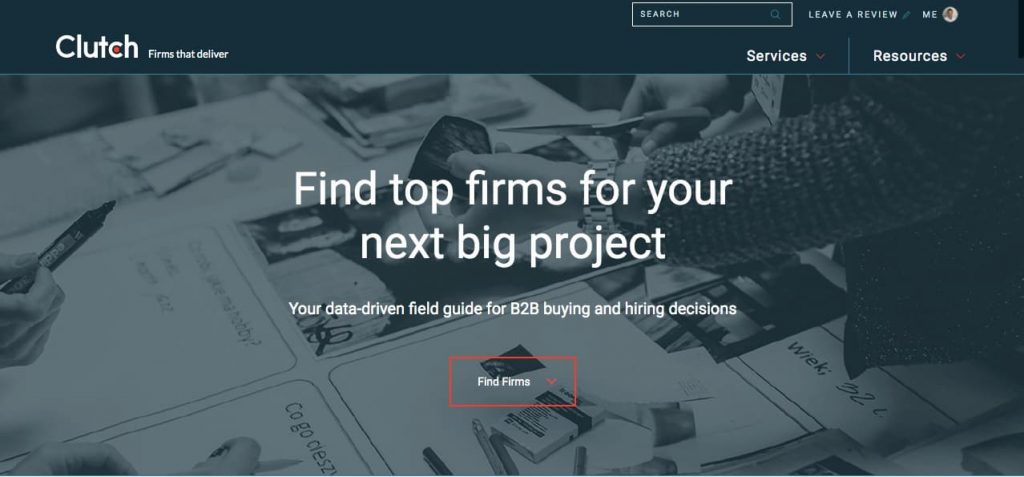
Apart from high-quality directories, there are major directories that people use (even if it’s from old habits) like Yellow Pages. It wasn’t too long ago that Yellow Pages was handing out those huge yellow books to homes and businesses for people to find each other.
That’s ancient history now, but many will automatically search for a local business using yellow pages because they are so well known.
City directories and major directories all represent streams of referral traffic that can be used to direct visitors to your website. The following is a visualized ecosystem of how information was shared across the internet in Canada.
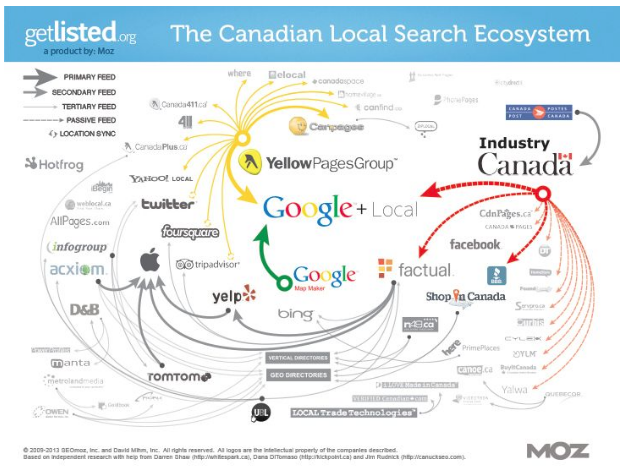
#8 Alternate search engines
With so much emphasis on Google, the other search engines are so easily forgotten. Google dominates the global search engine market, but there are still pockets of opportunities that exist.

Bing, for example, owns more than 10% of the desktop search traffic in the American search engine market and 9% of the Canadian.

Yahoo! Is the third largest search engine but consider that even companies that DuckDuckGo have a very small share in terms of the global market, 1% of billions of searches are still millions of searches being made every day and is worth the attention.
#9-Social media networks
There’s already been discussion about YouTube and influencer marketing but we haven’t touched on the topic of being your influencer on social media. There are so many social media users that you have several options to choose from that are more appropriately suited to your niche.
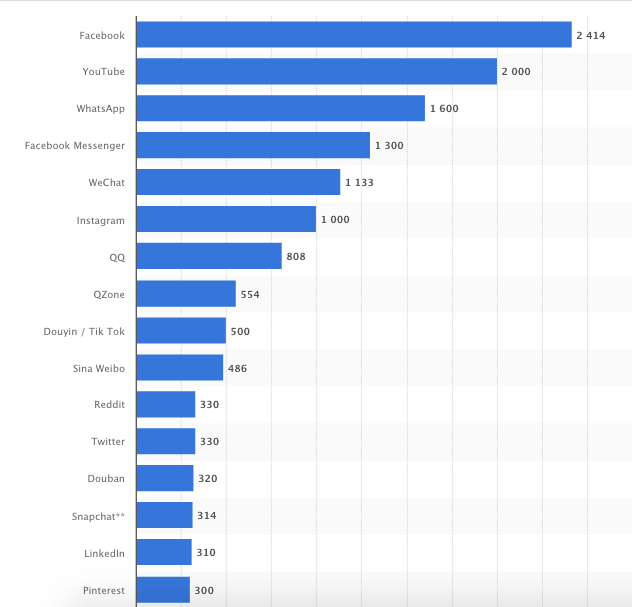
It’s obvious that Facebook offers the largest number of users, but there should be more focus on what type of social website your ideal client is using. If you’re selling high-ticket items or are a B2B service provider, LinkedIn is a good match for finding an audience that is more suited to what you offer.
Whenever your products are image-based, retail items, Instagram and Pinterest are undoubtedly among the most powerful websites to attract high converting visitors.
People like to interact with their favourite brands. They remain more loyal and are more likely to purchase from your company once they’re following you.
Choose 1 to 3 social media websites at most to build a presence where you can interact with users regularly.
Posting content once a week isn’t good enough. To successfully build a loyal and interested audience you need to comment, respond and share relevant content with your network.
#10-Email marketing
How could we end a list without including email marketing. This is one of the oldest forms of online marketing and yet it is still among one of the most effective.
Did you know that the average conversion rate from an email list is 3%, while paid ads are somewhere around 0.9%? This means that if you’re getting people to opt into your email campaign, you’re collecting a group of people with more interest in your content than the average person who clicks on a paid ad.
As an alternate source of traffic, you are in complete control over when you send people to your website. Even if Google blew up, with a big enough list you would still be able to get people reading your content and buying your products.
An email list is the perfect Google-proof solution to maintaining high volumes of traffic as well as increasing the sales and revenue you generate regularly.
There are more sources of traffic than just Google
As you can see, there are a lot of different options when it comes to driving traffic. Google owns the lion’s share of searches, but it doesn’t mean you can’t operate a business with a full-time income through alternate sources of traffic.
The way people search and interact with brands online has evolved dramatically over the years and will continue to do so. Make sure you have your hands in a few different cookie jars to maximize the traffic your website receives regularly.
Although alternative traffic sources exist, it’s nice to have the best of all worlds and keep your website in Google’s good graces.
Increase the traffic, leads and revenue your website generates with our custom SEO services.
Key Performance Indicators & Data Analysis
The key performance indicators found in the reports from your SEO consultant should be assessed for how visitors are responding to your site.
The information your site generates can be used to determine whether you’re on track in achieving specific campaign goals as well as indicate its strengths and weaknesses in achieving specific goals.
Google Analytics is a commonly used tool to track the performance data of your website. An analytics report will indicate where your website is falling short and how you can improve in those areas.
Sources of traffic
The traffic your site generates comes from multiple channels, which are separated, into paid, organic, social media and referral traffic. When assessing the traffic your site is receiving it’s important to understand how each channel performs individually to evaluate the effectiveness of each source.
Monthly search volume
When you’re engaged in SEO you should be aware of the traffic your site is generating. Are you getting the monthly traffic from the right channels? Is your monthly search volume declining or rising each month? Is this in line with the expected results of your SEO campaign?
Keep in mind that if your campaign targets low volume keywords that convert higher than it would be expected to have a lower search volume. In this case, the volume isn’t a KPI in your campaign, and you would want to see improvement from your engagement statistics.
Average time spent on page
The time a user spends on your page can be a good indication of their level of interest. If the overall time of your average user is increasing, this is a sign your visitors are spending more time engaging with your content.
The longer you can keep a visitor on your site, the more likely you are to convert them to a client. This is why the average time spent on a page, or dwell time is statistic your SEO consultant will try to improve.
Average pages viewed per session
A higher value indicates that your visitors like what they are finding on your site. If they are exploring page after page, your content is obviously on track in providing user intent.
When there are fewer pages viewed per session this could mean your internal linking strategy and navigation needs improvement. Connect your pages with links to related content to see an improvement in this metric.
Make your content accessible and easy to find starting on your homepage. If your visitor has topic options to choose from they are more likely to explore more pages on your site.
Conversions
Conversions are the goals you set up that you want visitors to accomplish on your website. The conversions you set up in Analytics can be anything from calling your business, filling out a contact form, subscribing to a newsletter, downloading upgraded content or making a purchase.
Your conversion rates give you insight into the flow of your content and how you funnel your visitors. Are you gently urging users towards your goals? Are you using an effective call to action for completing those conversions?
You can see where your users are exiting your website to make changes to pages that are not effective in guiding or converting your visitors to achieve your on-site goals.
New users vs. returning visitors
This is a useful metric to know whether your campaign efforts are reaching new users and driving traffic that will help to grow your business. Growth through new clients and more sales is the end goal, which means your site; needs to be attracting new users in order to contribute to the bottom line.
Bounce rate
When a user lands on your site and backs out, this increases your bounce rate. Analytics will measure the bounce rate based on whether a user clicks on any other pages on your site.
Although this indicator can show how well your site is being matched with your traffic, it won’t indicate whether you are providing exactly what the user needs-making there no reason for them to click further.
The lower your bounce rate, the better indication of higher levels of engagement. Keep your bounce rate under 50% and you’re in the average bracket for most websites. Here is an infographic from Crazy Egg showing the average bounce rate by industry.
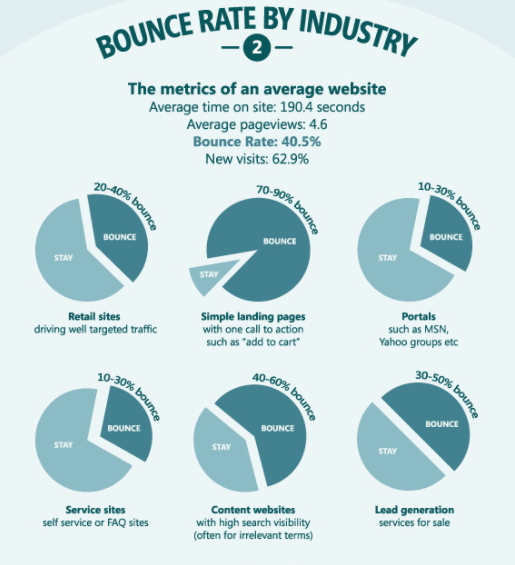
Search Console
The statistics in your search console will vary from your Analytics account. Here you can find stats and information that can provide you with more insight on how your website is performing.
Impressions vs. clicks
It’s important to know how many times your website is being displayed for specific queries. In the search console, you can see what keywords your site is being displayed for as well as how many clicks it’s receiving.
Understand your key performance indicators
In order to know how your website is progressing, you need an awareness of what it is doing now. Get familiar with the key performance indicators that apply to your campaign goals. Take the next step to increase the size of your business with our SEO services.
A Guide To Small Business SEO
Every small business needs SEO as part of its growth strategy. The search results are much too competitive to avoid search engine optimization completely and there’s way too much money to be made from an optimized website for SEO to be ignored. The truth is small business SEO is a complete game-changer if your website hasn’t been optimized to appear for important keywords to your business.
The opportunity exists in many industries where many small businesses haven’t taken the time or spent any resources on improving the optimization of their website. If your business is in one of these niches, a little goes a long way. Capitalize on the traffic opportunities Google provides where other businesses have not yet taken the initiative.
The reason these opportunities exist is that many small business owners either don’t have the time to optimize their site themselves or they don’t have the resources (not in the budget). What many small business owners don’t understand (or don’t believe) is that small business SEO leads to massive gains in your yearly income.
How can you afford NOT to optimize your website?!
This guide covers the basics of small business SEO. If you’re competing locally or target keywords in a moderately competitive search environment, this guide will teach you how to improve the search visibility of your website. The improved rankings, enhanced optimization ultimately generates more leads and traffic on a regular basis.
Are your pages indexed?
One of the first things you’re going to check is whether the pages on your website are indexed. You’d be surprised at the number of things that could happen that lead to a company’s website being removed from Google’s index. You’ll want to eliminate that possibility before doing any work on your site.
If your pages aren’t indexed, you won’t show up anywhere on Google. Use the site search operator to tell Google to list the pages of your website by entering the following in the search box:
Site:[your domain.com]
This command will look for and list every page on your domain that Google has indexed.
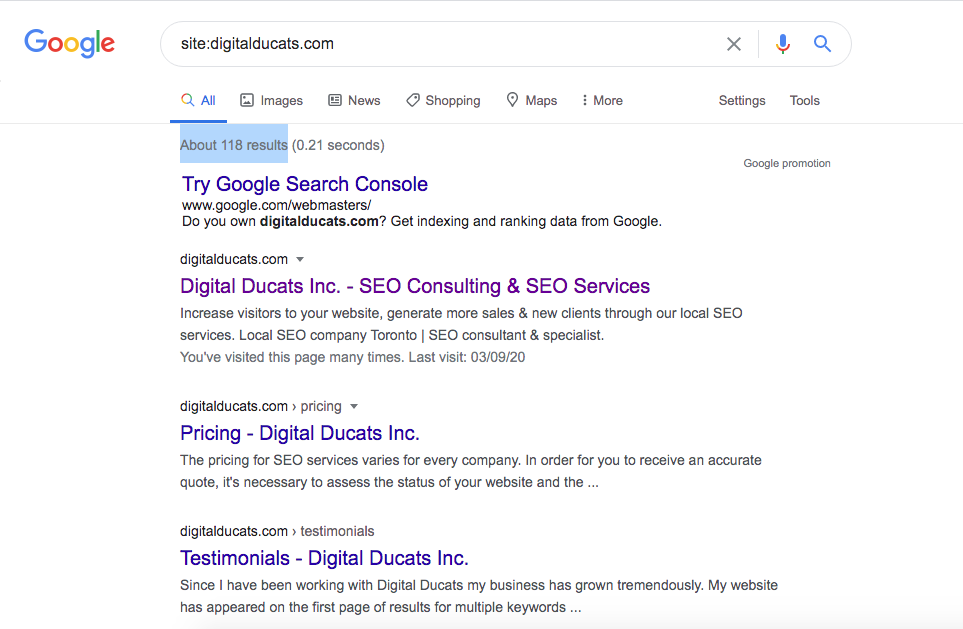
It’s a bad sign if your homepage doesn’t appear at the top of the search results.
It’s even worse if none of your pages show up!
In the event your pages aren’t being listed, you’ll need to dig further to find out what exactly is happening with your website.
Google’s Search Console
If you haven’t signed up for the search console, you should do that immediately by clicking here. The search console is your way of looking into most of the issues that go wrong with your website. The search console can provide you with unique insights regarding the inner workings of your site.
There is a tab on the left menu that specifically shows you how many pages your website has on Google’s index. This tab also shows you how many pages have errors that need attention.
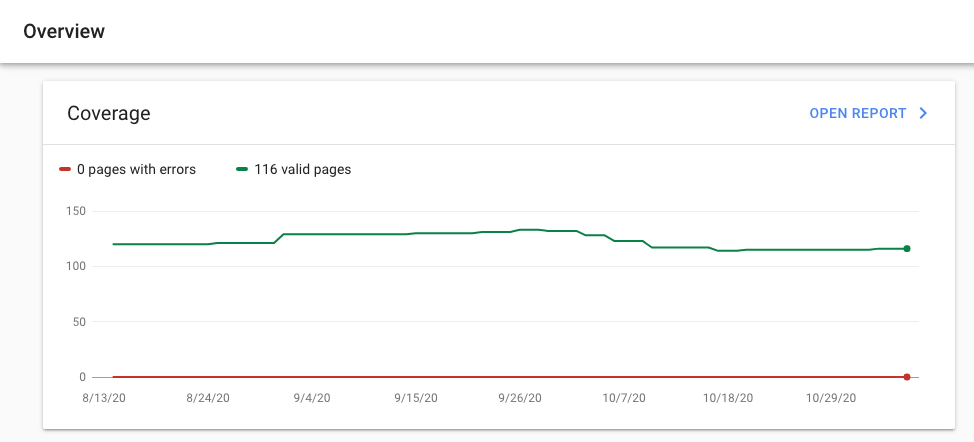
Check for manual actions
If your pages are not indexed one of the first areas you should check is the manual actions tab. This is probably the worst thing that could happen to your website since it means Google has issued a penalty for violating its Webmaster guidelines.
Most penalties are based on exposing specific types of ranking manipulation. If your website has accumulated too many unnatural links it’s cause for google to cite you with a manual action penalty. Manual actions will in almost every case result in the removal of your website from Google’s index.

If you don’t have any manual actions, you’re going to need to check your website for any mistakes that could have been made.
Check your general settings from WordPress
WordPress has a setting you can find under Settings, Reading, where there’s a radial button you can select that tells search engines to ignore your website. If it has been selected, none of your pages will be indexed. Make sure the setting is unchecked.

The last place you’ll need to check is your robot.txt file. This is a file on your site that instructs search engines which pages to ignore. If there is a command on this file that shouldn’t be there, your pages may not be indexed.
If your pages are indexed, let’s move on to the next part of optimizing your website.
Technical performance
It’s important to get an overview of the technical performance of your website. Use SEMRush, Ahrefs or Moz to scan your site for any issues that could be affecting your overall ranking such as page speed and missing pages.
Missing pages (404 errors codes)
Too many errors on your website is never a good thing. Missing pages contribute to a poor user experience. When a user clicks on a link and is taken to missing pages it can be frustrating and lead to them completely abandon your site altogether.
You can discover the missing pages on your site that are generating a 404 code by running a site audit using a number of different tools. Here’s an example of a SEMRush report on the overall site health of a website.
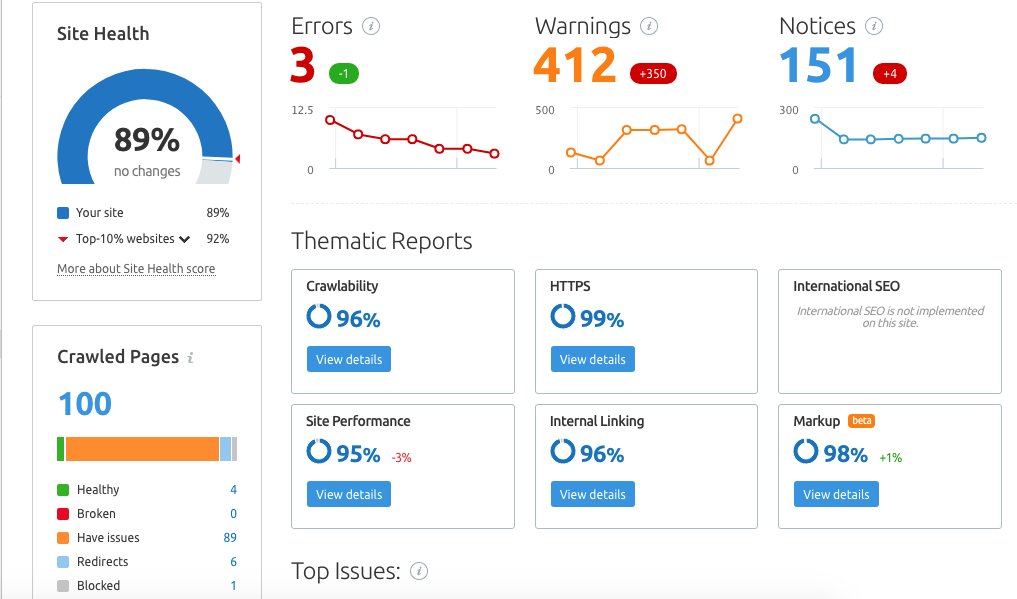
You can discover the missing pages on your site that are generating a 404 code by running a site audit using a number of different tools. Here’s an example of a SEMRush report on the overall site health of a website.
The report will list the missing pages on your site so you can correct the problem. The options you have for fixing the issue is to either:
A) Redirect the old URL to another page with similar content
B) Republish a page with the same URL.
C) Change the links that are pointing to the deleted page (could be internal or external)
Check for slow page speed
Slow page speed is bad for business. It was declared an official ranking factor by Google itself back in 2013 and apart from that can repel visitors from your site if your page takes too long to load (known as the bounce rate).
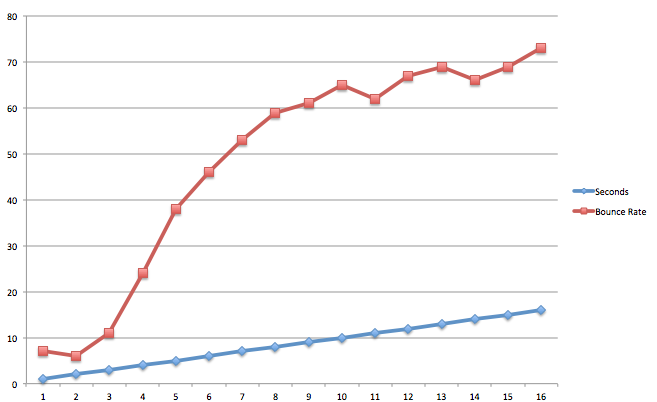
Slow page speed is bad for business. It was declared an official ranking factor by Google itself back in 2013 and apart from that can repel visitors from your site if your page takes too long to load (known as the bounce rate).
You have a variety of tools to choose from to test your page speed such as Google PageSpeed Insights, Pingdom, GT Metrix.
Enter your URL in any one of these tools and get a page speed score. Each one of these tools also provides you with a report that will detail the reasons your page is loading in the time that it is.
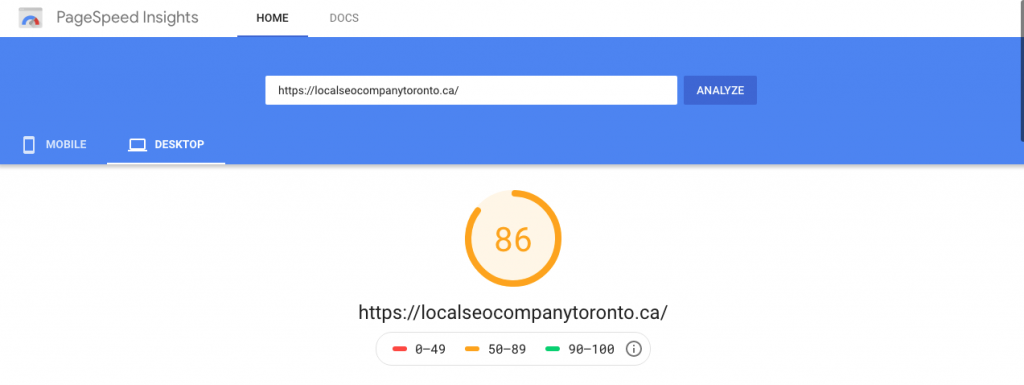
Enter your URL in any one of these tools and get a page speed score. Each one of these tools also provides you with a report that will detail the reasons your page is loading in the time that it is.
Identify, assess and prioritize keywords
Choosing the keywords your website targets is an important part of strategizing the traffic your website generates. The keywords you select impact the quality of traffic your website receives, so it’s important to make sure that you have a good grasp of the terms that represent the most value.
Brainstorm your top search terms
List the major services, products or topics of your website. These will represent the major pillars that are essentially the most important aspects of your business. Break down each topic with a list of keywords that contribute to providing an accurate description of the topic.
There are dozens of tools to use where you can generate relevant search terms. Eventually, you’ll need to assess the metrics of each keyword to choose search terms that have an appropriate volume of monthly searches and are not overly competitive.
By establishing your major keywords early on in your website development you can incorporate those terms in the metadata of your pages from the start. Going back to correct these types of issues after publishing your pages can cost you time, resources and search visibility.
Identifying the best keywords for your site in a topical manner establishes a direction for your blog content. Publish related articles that contribute to a better understanding of your major keyword topics, the stronger your website becomes in this area.
Establish search intent
In order to publish content that ranks for a keyword, you need to know exactly what users are looking for when they use that keyword in a search. Enter your keyword in Google and survey the 10 organic results. Make sure they are websites similar to your own and you’re offering a better version to what’s on the first page of results.
Assign value
Qualify your keyword selection by assigning commercial value to each search term. Use the cost-per-click value as an indication of commercial value. If there are. a lot of publishers bidding on this keyword, it drives the price up. A high CPC value indicates people are making money on the traffic from your keyword.
Check for a minimum volume of monthly searches
If your keyword gets zero searches a month-what’s the point of ranking for it?! Choose keywords that have enough volume to drive traffic that converts. Remember that the total search volume doesn’t mean your website will receive it all. You may be looking at getting a small percentage of that traffic since it gets divided amongst the SERP features and 9 other websites competing for your keyword.
Filter out high competition keywords
Part of the keyword selection process is to recognize the terms that will take too long to rank for on the first page of results. Highly competitive terms are usually dominated by high authority websites. If you don’t own a high authority website, or your domain authority is dwarfed by the competition, avoid that keyword.
Consider keyword variations or long-tail keywords as alternative solutions where you can capitalize on traffic in a shorter and less labour intensive period of time.
Long-tail keywords
Create a short term goal and a long term goal for every page that points to your pillar page by targeting long-tail keywords. Over 50% of all search terms are more than four words. By creating a longer search term you will reduce the competition that’s optimized for the key phrase. Adding more descriptive terms to your keyword will drive more targeted traffic to your site.
Create long-tail keywords by forming a question using your seed keyword. This will set the stage to optimize for featured snippets, PAA boxes (People Also Ask) and voice search. Over 80% of Google home results are displayed from featured snippets.
Ask your question in every form of “who, what, where, when, why and how.” You can make your own list or seek the assistance of Answer The Public. By typing in your keyword on the dashboard of this site it will return a list of questions using who, what, where, when, why and how.
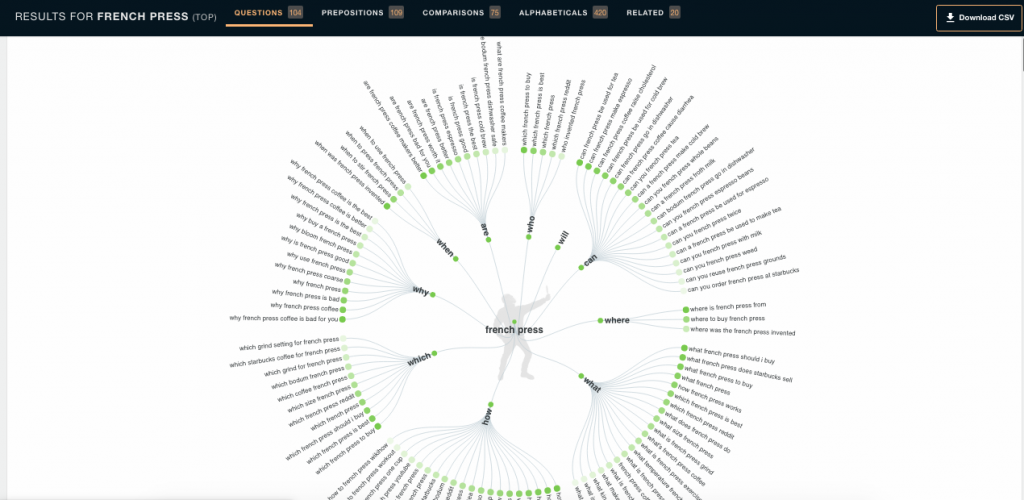
Additionally, Answer The Public will also produce reports on what words are most often combined with your keyword, what phrases are most typed and offers this info in as a visual display or in list format. You can export all of the results generated but keep in mind you have a daily limit for how many reports you can generate.
Local keywords
If you’re a local business, choosing your keywords can be fairly simple for appearing in localized searches. Most businesses optimize for their service (or product) + city or vice versa.
If you’re a plumber in Toronto your top keywords are going to be plumber Toronto and Toronto plumber.
Where you can accelerate the traffic your website generates is to break down your major keywords into as many subtopics as possible to create more traffic opportunities.
Identify additional search terms that your clients are searching as a way to expand your reach and get more people on your website. Some of the top plumbing terms that plumbers in Toronto would consider are:
- Emergency plumber in Toronto
- Cheap Toronto plumber
- Plumbing company Toronto
- Plumbing services Toronto
Map out content that satisfies the search intent for each of your major search terms. Use a combination of blog posts and service pages, to come up with the keyword strategy that drives local traffic at each stage of the buyer journey.
Content creation
Every page you publish on your site should have a specific purpose. As a small business, you should be using content to move your visitors closer to making a purchase. This process is otherwise known as the marketing funnel which lists the stages of the buyer journey.
Marketing funnel/buyer journey
The buyer journey or marketing funnel concept suggests that people go through a series of stages before actually making a purchase. Create content to address each stage of this journey to equip your website with the ability to satisfy multiple search intents.
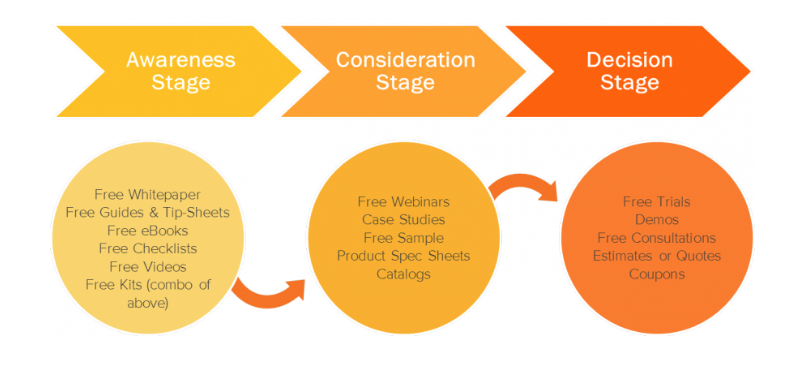
No matter what stage of the journey a visitor is on when they land on your site, you can guide users further along in their journey and get them closer to making a purchase.
The decision stage
Visitors in the decision stage know exactly what they’re searching for and are ready to make a purchase. These users are considered to be at the bottom of the funnel and have likely searched Google using brand searches, product descriptions, service searches, etc.
These keywords are transactional in nature and your service pages should target these phrases since users are looking to buy what they need.
The consideration stage
The consideration phase is where users may know what they need, but they’re comparing the products and services from different companies. They’re exploring their options by researching the advantages and disadvantages offered between competitors.
Content that addresses this stage can be case studies, independent research, reviews and any type of content that convince a user to purchase a product or service.
The awareness stage
At this stage, users are searching for information, however, they may or may not know what the solution is to their problem, or what their problem even is. Content that targets the awareness stage is basic explanations of products and services or solutions to common problems.
For example, someone who has psoriasis may be searching the symptoms they’re having, not really knowing how their condition can be solved.
If your website offers skin hydrating solutions, then publishing an article about the symptoms of psoriasis and how it is treated would be ideal for making people aware of your product.
Not only do they become educated about their condition, but they learn how your product is a solution for it as well.
This concept of building awareness is how many websites are able to grow your business. It allows you to target a much broader audience than would never find your website without being made aware of what their problems are and how they are solved.
How to create content that outranks the competition
Search engines aim to display the best answer to search intent. If your page is not one of the 10 best pages to answer the users’ intent of the search, you’re not going to drive any traffic from that keyword. To create content that outranks the competition, publish versions of content that are superior to anything that ranks on the first page. This is where SEO content writing is extremely advantageous.
Satisfy search intent
Scanning the first page of results is a practice that will reveal similar characteristics in the content that’s being published. Check for a dominant type of content that ranks highly to determine what will give you the best chance of ranking on the first page.
Go through each page to assess the topics that are covered. By scanning the headings you should get a good idea of the topics that have been highlighted. It will be important that your page addresses everything the top-ranking pages cover, and more.
You can add more value to your content by extracting clues that hint at search intent from the SERP features that are present. Use questions from the PAA box to expand on your content. If Google has these questions listed in the box, it’s a way of suggesting that they are relevant questions related to your keyword.
If specific types of multimedia appear on the SERP, be sure to incorporate these forms of multimedia within your content.
The idea behind answering search intent is that you provide the best response to the keyword search by demonstrating your page has the ability to cover the most important aspects of the keyword topic.
Implement the skyscraper technique with 10X content
The skyscraper technique and 10X content refer to the same concept of publishing a page that is better than what ranks in every way. Aim to be more detailed, cover more topics, add more multimedia and provide a better user experience than the competing pages.
Optimize your pages
At the most fundamental level of on-page optimization, your page needs to be optimized to appear for the keywords you target in the organic search results. You can also optimize your pages to drive more traffic from additional features and positions in the SERP.
Basic on-page optimization
The metadata is the information the search engines will receive first. Place your keyword within the H1 tag on your page to tell search engines it’s one of the most important descriptive words for your content.
The title that’s framed in H1 tags is what shows up on the search engine result page. If you’re using a CMS then it’s more than likely your page title is automatically tagged for you. WordPress handles this for you.

The URL is also a major descriptive element of the content on your page. It’s important to keep your URL short and descriptive. Your keyword alone will often be the perfect solution to an optimized URL.
Avoid auto-generated URLs that make no sense to users or search engines. Even using dates and times is problematic if you ever want to update content. Plus they don’t help with optimizing your page for your keyword.
Use your keyword in your meta description to attract users. The meta description is not specifically used by search engines for determining optimization, but it can influence whether a user clicks on your page from the SERP.
Incorporate your keyword and its variations within the alt tags of your images. Search engines put the most emphasis on how to categorize your images by what’s written in the alt tags.
The filename and captions are also additional hints for optimization so make use of them as well with descriptive keywords and synonyms.
Structured data markup
Implement structured data markup whenever the opportunity presents itself. This form of metadata is invisible to users but is useful for search engines. The added markup makes information more readily available and provides additional context to your page.
A web page that uses structured data markup is more likely to appear in voice search results. In fact, 36.4% of voice results have structured data markup.
Rich results are also attainable with structured data markup. If you can enhance your search result listing with a rich result, you can increase the traffic your site receives from higher click-through rates.
Enhanced search results capture more attention from users who are scanning the results. The increased click-through rates ultimately can lead to an improved position on the SERP since it happens to be a metric measured and monitored by Rankbrain, (Google’s AI program for determining website ranking).
Optimize for SERP features
Google will display different SERP features depending on the keyword used in a search. For instance, if you add near me at the end of a search, Google recognizes you’re looking for a local business and will display the local finder.
Optimize for the features that appear on the SERP to give your content more ways to drive traffic from keyword related searches.
Featured snippets give your business an advantage over other search results by being the first item at the top of the page as well as the fact that it’s an enhanced search result.
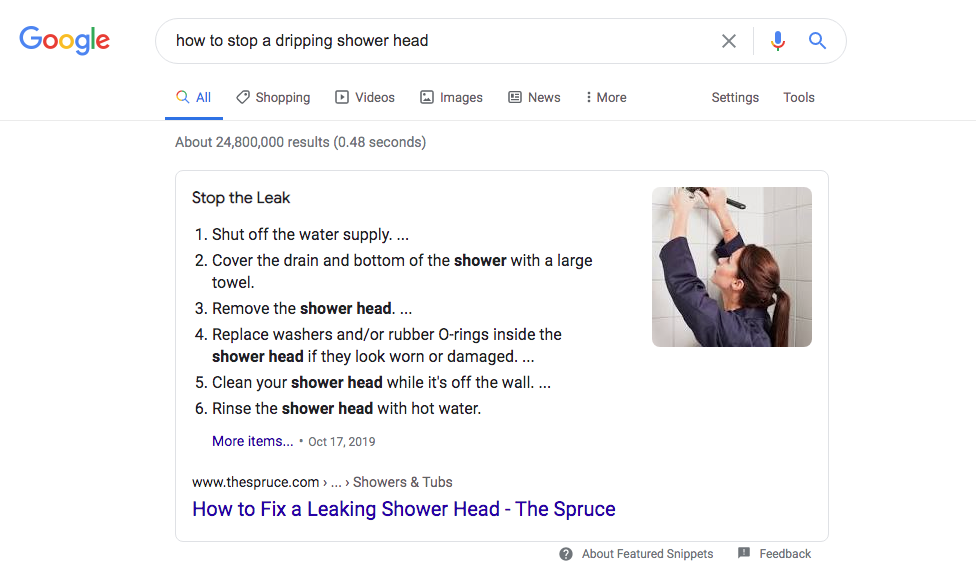
Appearing in a featured snippet contributes to branding your company as an expert in addition to driving the most traffic from the keyword search.
PAA boxes are also another feature in which you can optimize your content and drive additional traffic to your website. Answer the questions you find in the PAA box by keeping your answers short and direct.
Link building for small business owners
It needs to be made very clear that backlinks can and do play a very important role in providing your content with credibility, authority and overall ranking ability. Although it may not be extremely necessary to engage in advanced link building tactics, you can implement basic tactics that can result in some high-quality links to your website.
A quality backlink is one that comes from a website within your niche, industry or a close vertical to it. You want the link to represent a vote of credibility for your content. In other words, it’s like getting other companies to vouch for you.
Link relevance is the most important aspect of how much positive impact a link has on your website.
The second aspect of a quality backlink is that the website who links to you also has quality backlinks. Search engines will assess the credibility and authority of every website that links to you-which are done by checking their backlinks.
The higher the authority in your niche, the more impact the link has on your website. Therefore if you want to acquire the best backlinks possible for your website, look for the most trusted names in your niche/industry with the most domain authority.
Find client/vendor links
Considering that relevance is the most relevant factor, one of the first places you should look for a link is from your vendors and clients. Their websites don’t get much more relevant than that.
Many companies have published pages in which they link to their clients and vendors and list them as resources or useful links. You can also find these types of pages on your vendors’ websites that would be published as stocklists or pages titled “where to buy.”
You can search your client websites by using the following search operators on Google:
- Site:yourclient.com + inurl:”links”
- Site:yourclient.com + intitle:”resources”
- Site:yourclient.com + intitle:”links”
- Site:yourclient.com + inurl: “resources”
Search your vendors’ website by using the following searches:
- Site:yourvendor.com + intitle: “stocklists”
- Site:yourvendor.com + intitle:“where to buy”
- Site:yourvendor.com + inurl:“stocklists”
- Site:yourvendor.com + inurl:“where to buy”
You may have noticed that the commands can be mixed to tell Google to look into either the URL or title.
Your first tier of links should always reflect credible sources that have some sort of authority in your niche/industry.
Look on both your clients and vendor’s websites to find relevant link opportunities from those who are the most likely to give you the link.
There are a number of other ways to acquire high-quality backlinks for your website. The level of difficulty in executing these strategies can vary depending on your own strengths.
Many business owners need to get familiar with how to build local backlinks. If your audience extends past your locality you may want to consider guest blogging for quality links and referral traffic to your website.
Drive traffic from Google Local Pack/Finder/Maps
Whether your business has a physical location or not, you should definitely be listed in Google’s local finder. The local pack is often triggered in searches for products and services if local businesses are optimized for those keywords. Optimize for local SEO to drive high-converting traffic with less competition.
Approximately 45% of searches are made to obtain information on a local business. Capitalize on the traffic this feature can provide by signing up for Google My Business.
Once you’ve registered, you will need to verify your listing by postcard.
Use your home address if you’re a service area business. If you’re a partner in a business, use the person address that is closest to the centre of the city you’re optimizing for.
You’ll get the most impressions when you’re business address in the most densely populated areas.
Use every opportunity to enter your information into the fields that Google My Business offers.
- Enter your address (if you service a large area and do not have a brick and mortar address you should leave the address field blank)
- Upload images.
- Add your logo.
- Post content on Google posts.
- Answer questions on the knowledge panel.
- Include the most appropriate categories.
Google will extract that information when a local search is made in your area. You want to have as many reasons as possible to be listed in the top ranking positions of a keyword related search.
Encourage reviews
Reviews are a ranking factor that will contribute to where your company is displayed in the local finder. The more five star reviews your company receives the more likely you are to appear in the local pack (top three sites listed on the first page of search results).
Detailed, keyword-rich reviews will go a much longer way than short reviews. Encourage your customers to talk about their experience with your company to get the most of reviews as a ranking signal.
Extend your reach through social media
There is no denying the power of networking through social media. The goal of your company is to get as many people on your website as possible. Post your content and be engaged in sharing people’s content, and commenting as much as possible to continue building a following.
Choose one or two sites that you will be engaged in making your presence felt. This doesn’t mean to limit the number of profiles you create- it helps you to be more consistent in commenting and responding to comments and questions.
Include as much video as possible when posting to your networks. Video gets the most shares and produces the highest levels of engagement. People prefer to watch a video than read a long block of text.
Share other members posts to show support and encourage them to share your content as well. Leave a call to action on all of your posts as well as links to your website.
A large social network can create a surge in the traffic your site receives when you share high-quality content. The more people that are on your site create more opportunities for people to link to your site and improve your ranking. Entire businesses are made from the traffic social media provides so maintain a constant presence a continuous effort to build a network that becomes a valuable asset.
Increase revenue with SEO for small businesses
Search engine optimization is undoubtedly the most powerful inbound marketing strategy you can implement for your business. Google provides the largest source of high converting traffic that you can receive on a regular basis.
Incorporate SEO into your growth strategy. Whether it means making room for it in your own busy schedule or making room for it in your marketing budget, the ROI you receive is well worth the effort.
Our company specializes in small business SEO services and will cover everything mentioned in this guide and more. To get started with a website audit, contact us for a free consultation.
Generate More Leads With Authoritative Content
When you invest in SEO services for your business, you’re creating a stronger foothold in your niche to drive targeted traffic and generate more leads. SEO is the top inbound marketing priority for 61% of companies. Your company becomes a familiar sight in the search results for people searching for terms that are related to your business. This promotes recognition in your industry and will naturally drive more traffic to your website.
Identify user intent
It should be noted that although keywords play an integral part in the optimization of your site, the way they are used has changed entirely since semantic search was introduced.
Search engines are now extremely adept at ascertaining the meaning of content on a website and determining whether it will satisfy the user intent behind a search query. This fact alone has forced websites to provide the information a user is looking for as an ideal outcome from their search.
Adequate keyword research will not only identify what people are typing to find what you offer but what is directly related to what they are looking for. This point takes us back to finding the true search intent behind keywords.
We know that someone who types the phrase “bathroom renovation” will also be interested in countertops, cupboards, sinks and bathtubs. Therefore it would make sense to include those subtopics in the content for the page on bathroom renovations, but also to link out to separate pages that take each of those subtopics and explain them in more detail.
Create keyword clusters
Keyword research is not only choosing the keywords with the highest volume, and lowest competition, but also finding the related keywords to paint a more detailed picture on the entire keyword topic. This is known as a keyword cluster, which lays the foundation for the content that needs to be created on-site.
This type of structure is highly effective for better traction in the search results because it demonstrates a more in-depth knowledge of a particular topic. Each subtopic from your main keyword presents more opportunities to pursue more focused keywords that are directly related to your main keyword.
The traffic from each spin-off article from the main page will attract customers from different aspects of your service. This traffic shares similar search intent, which ultimately generates more leads and new clients from higher volumes of traffic.
Articles that are published with this type of focus will continue to build on the presence and reach of your company. Keep in mind that just publishing an article isn’t enough to automatically generate traffic. It needs to rank in order to start driving traffic to the site.
Optimize on-page
Search engines assess how deep a site goes into a topic but will also look for specific signals that indicate what keywords in which the page is optimized. Your page should be hyper-focused on a particular subject within a keyword topic and optimized to reflect a specific search term.
On-page optimization is crucial for influencing your page to appear for specific queries. The placement of your keyword emphasizes the focus of your content and promotes positive ranking signals for your keyword or phrase.
Increase ranking ability
Building links to a page increases the authority and pushes the page up towards the first page of results. Link building is a mandatory strategy for most competitive keywords with commercial value.
Due to historical manipulation of link building tactics, the practice can be quite treacherous if performed improperly. Outdated strategies and black hat tactics can cause your website to tank in the rankings, or even worse be removed from Google’s’ index.
One of the preferred methods of link building for businesses is guest posting. This method gives companies the opportunity to brand their business while building links.
An article is published on behalf of your company on high-traffic blog sites within your niche. This allows your company to reach a larger audience with an article that demonstrates knowledge and expertise within the industry.
The larger sites are more difficult to get published, but when accepted can land you some very powerful links as well as targeted referral traffic. As more content is published on your behalf your website grows more powerful in authority and you add to the streams of traffic being driven from an improved ranking position and from each referring blog site.
Generate more leads
It’s possible to have quick results from an SEO campaign, but the best results are seen in the long run with the accumulation of higher volumes of traffic regularly driven to your website. An SEO consultant develops your website to generate more leads, attract more clients and increase revenue.
Page Speed: A Complete Guide For 2020
Oct 23, 2023 @ 7:26 amPage speed has been an SEO issue ever since Google made it an official ranking factor in 2015. The importance of page speed is paired with the significance of providing a better user experience, an important aspect of user engagement. Now it remains an important factor that could save you clients and revenue.
What exactly is page speed?
Page speed is the measure of time it takes for your page to load (not to be confused with site speed, which is the overall speed of your website). Page speed is measured by the time it takes until the first contentful paint (FCP), which. is the first appearance of content.
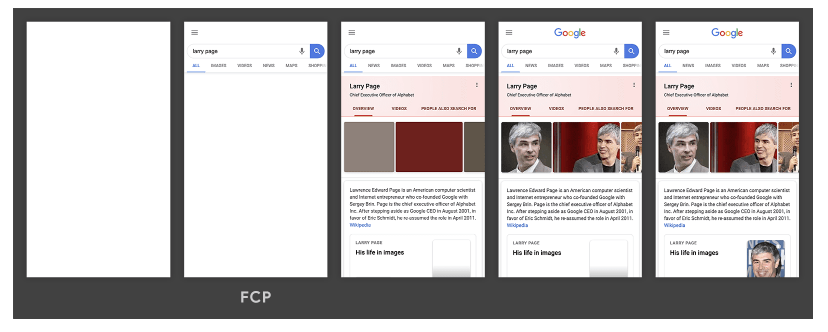
Every web page has a sequence of items that need to load before we see the full web page. The browser loads a page in the order it’s prioritized. You can increase the speed this all takes place by improving any or all of a number of the issues that can cause a bottleneck and result in slower load time.
What are the benefits of fast page speed?
The time it takes your pages to load can have a significant impact on the performance of your website. If your site is already fast, the improvements might be marginal, but the long-term benefits will be substantial.
Reduced bounce rate
By far, this is one of the most well-known improvements you can make to your page because it has such far-reaching implications. The bounce rate of your site is the percentage of people that land on your page and back off of it without clicking through to other pages or reading any of the content.
Generally, a high bounce rate indicates the user is not interested in what they’ve found when they land on your page. Studies have shown that there is a direct, inverse correlation between page speed and bounce rate. The faster your pages load, the lower your bounce rate becomes.
The opposite is also true where the longer it takes your pages to load the more users will bounce off of your page.
According to Google, every second in load time represents a percentage of visitors who will back out of the site in search of another that loads faster. This becomes very apparent after three seconds.
The logic behind the relationship between page speed and bounce rate is simple; People hate to wait and when their patience is tested, they will leave your website in search of another whose pages load faster.
Increasing your page speed will literally keep more people on your website.
This discovery led retail giants to save billions of dollars every year. The more they improved page speed, the more they reduced abandoned shopping carts and increased their revenue.
The general consensus among people is that they tend to distrust websites that take a longer time to load. Long load times equate to poor user experience. If Amazon experienced a loss in potential business and they are one of the most trusted sites in the world, what do you think people will think of your site if it’s not loading in a time that’s up to the status quo?
So what is the status quo for page speed? Below is a chart of the average load times across different industries.
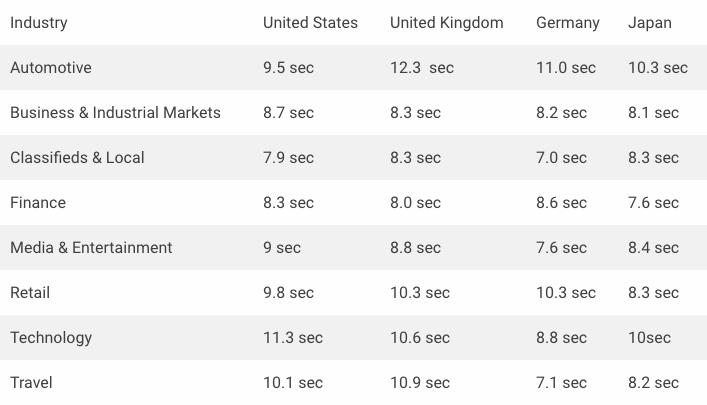
What you can draw from this is that although there is a heavy emphasis on improving your pages load time, there are still a lot of websites that haven’t conformed to the recommended standard set by Google of 3 seconds.
This presents an opportunity to get your site faster for a competitive advantage that contributes to ranking and a better user experience than what your competition offers.
Now that we can all agree that the faster your page load time, the more visitors stay on your site, there are a bunch of good things that happen from the domino effect.
Fast page speed improves your click-through rate
More visitors staying on your pages means a higher click-through rate. If your pages are loading faster, you’re getting more of your content in front of them to find and click through to on your website.
Longer dwell time
With more users able to click through to more pages, the average time spent on your website is going to get longer. Longer dwell time demonstrates a positive signal that will benefit your website’s search visibility from improved ranking.
Increased search visibility
Improved page speed leads to improved user engagement, which is also a positive ranking factor that becomes highly relevant on the first page of results. Rankbrain is one of Google’s artificial intelligence programs that is specifically designed to assign rank positions.
Rankbrain measures user engagement statistics along with other ranking factors to determine the popularity of a website and whether users are enjoying the content they find. Your site will experience increased search visibility from a higher ranking.
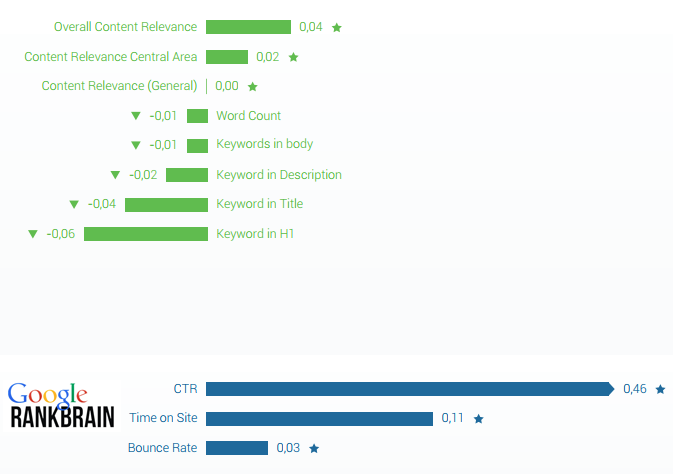
Increased volume of traffic
Higher rankings will almost always mean an increase in the volume of traffic your website receives. Apart from the rise in traffic from improved ranking, the increased volume of traffic that stays on your site provides your website with more opportunities to convert visitors into clients.
Higher conversions
Longer dwell time and higher click-through rates are the perfect recipes for increased conversions. The more content you can get in front of your audience, the more opportunity you have to build trust and guide them to products, contact forms or making a phone call. The conversions on your site will naturally increase.
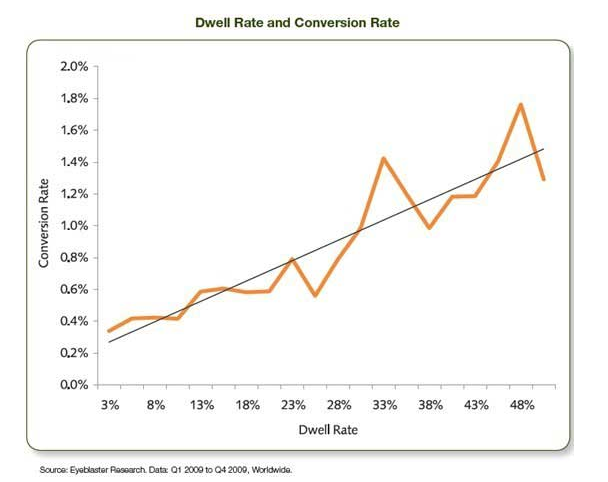
Time is money. Walmart and COOK have reported huge percentages of increase in profit by reducing their pages load time. Walmart increased conversions by 2% with every second of increased speed. Cook increased load time by 0.85 seconds and enjoyed a 7% increase in conversions. (~Radware Blog)
In the chart below, mPulse Mobile was tested for its conversion rates vs. load times. The case study was performed by Skilled and here are their findings :
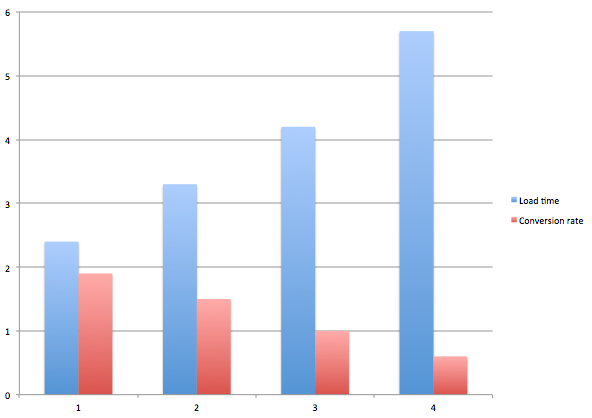
Comparative Case Study
- At 2.4 seconds they had a 1.9% conversion rate
- At 3.3 seconds conversions were 1.5%
- 4.2 seconds was less than 1%
- 5.7 seconds and higher was 0.6%
Increased revenue
The ultimate benefit of increased page speed is the increase in revenue your company receives. The law of averages suggests that the more visitors that land on your website (from relevant search terms), the more conversions and sales your website will experience.
If your website traffic goes from 500 visitors a month to 1000 visitors a month, you can expect to see a direct relationship in the revenue your company receives. Improving the page speed within your website will ultimately increase the revenue your website generates on a regular basis.
How to improve your page speed
- Test your speed
- Images
- Minify HTML, CSS and JavaScript
- Leverage browser caching
- Lazy loading
- Use CSS Sprites
- Use a CDN
- Delete unused plugins
- Choose the right hosting plan
Test your page speed
The first step to increasing your page speed is to get a report on the actual speed of your page. Included with your actual page speed will be a list of items that you. can do to speed up the load time of your page.
How do I test the speed of my website?
Go to any of the following websites to generate a report on the speed of your website.
- Pingdom
- Google PageSpeed Insights
- Google Mobile Website Speed Testing Tool
- Google Analytics Site Speed
- WebPageTest
- GTMetrix
- KeyCDN Website Speed Test
- DareBoost
- Web Page Analyzer
- YSlow
- Chrome DevTools
- Load Impact
- Site Relic
- dotcom-monitor
- New Relic
You can any of these free tools but why not go straight to the source by using Google PageSpeed Insights.
Enter the URL of your page and you’ll receive a page speed score out of 100 on both desktop and mobile.

Scroll down to view a list of items that are affecting your load time.
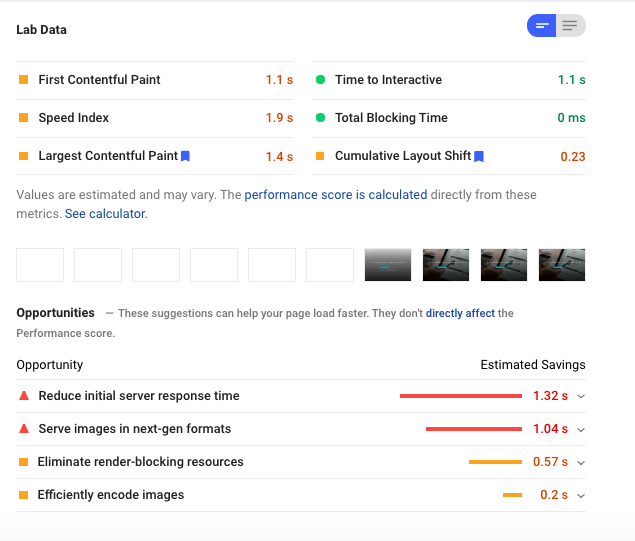
Every website will experience its own unique issues but for the most part, the following are the most common fixes and should be incorporated into a routine to maintain the time it takes for your pages to load.
Whats a good page speed score?
If your page scores a 90 and above, your page is considered to have a “good score” A score between 50-89 is considered to “need improvement.” If your page scores less than 50 it’s a bad score that needs immediate attention.
Reduce the size of your images
Images are one of the leading causes of slow page speed, however, there’s a lot you can do that directly affect your pages load time. The first is to reduce the file size of your images by reducing the dimensions and pixels you upload onto your site.
Choose the exact dimensions that are needed in order to eliminate the need for additional resources requests from the server.
When you upload an image taken directly from a camera, the file size is often 1000’s pixels in width and length. If the required size is smaller than the actual image size, you can streamline the time it takes to load by only uploading an edited version.
Use the correct image formats
Another way to reduce the size of your images is to use the most appropriate formats than enable compression. GZIP is ideal to use on your website for the smallest version of your images.
Choose PNG and JPEG as the preferred formats. PNG is mostly for web colours, which is ideal for charts, graphs, banners, etc. JPEG is best for actual photos with a more complex range of colours.
Remove unnecessary metadata
Many cameras will embed information into the images it renders. Removing the unnecessary metadata can reduce the file size and streamline the load time.
Use lazy loading
Lazy loading prioritizes the sequence of loading images on your page. The priority is given to the images that are located above the fold and in plain view when a user lands on a page. The images below the fold are delayed loading until the user scrolls down.
Prioritizing this sequence on your page allows more resources to be dedicated to the content that is immediately being viewed. When the user scrolls down, the images are then triggered to load, which is faster than having the entire page load at the same time.
Minify and inline HTML, CSS & JavaScript
You may see on your page speed report to minify and inline scripts and languages such as HTML, CSS and JavaScript. This refers to streamlining the code that is found in the header of your website.
Most WordPress sites are built from templates and the code used in the header will often have notes and many spaces between the lines to separate segments. These spaces are mostly for human developers since the bots that read the headers don’t need the spaces to differentiate segments or the notes for their understanding.
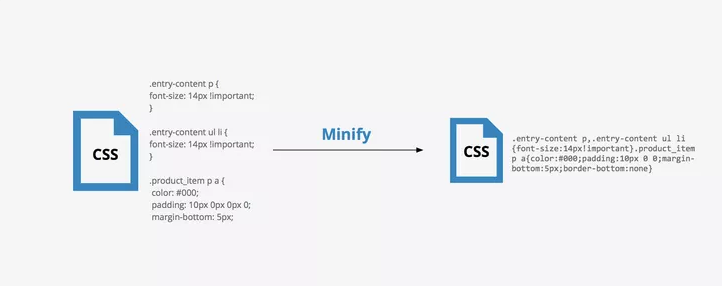
You can reduce and compress the code on your page by eliminating both. It may seem difficult, but you don’t need to do this on your own. Some plugins will do the work for you-we’ll name a few tools you can use later in this article.
Leverage browser caching
You can lighten the load your server takes on by enabling a command that tells browsers to save the most important files on your site. Browsers will save images and other time-sucking resources so that after the first visit from a user, those files are ready for display in a fraction of the time it would take to retrieve them from your server.
Browser caching increases your page speed by reducing the number of server requests you make when loading your website.
Use CSS sprites
The use of CSS sprites can save load time by using a template image that includes many smaller images that can be used on different parts of the page.
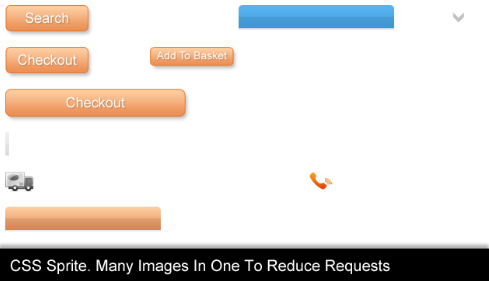
Rather than have the server make multiple requests for each individual image, you can choose to show the parts of the image to use on the different parts of your website.

Use a CDN
A content delivery network is ideal for reducing server response time. Your website data is loaded into servers that are strategically placed around the world. Whenever your website is accessed, the information is taken from one of the remote servers as opposed to being requested from your hosting company servers.
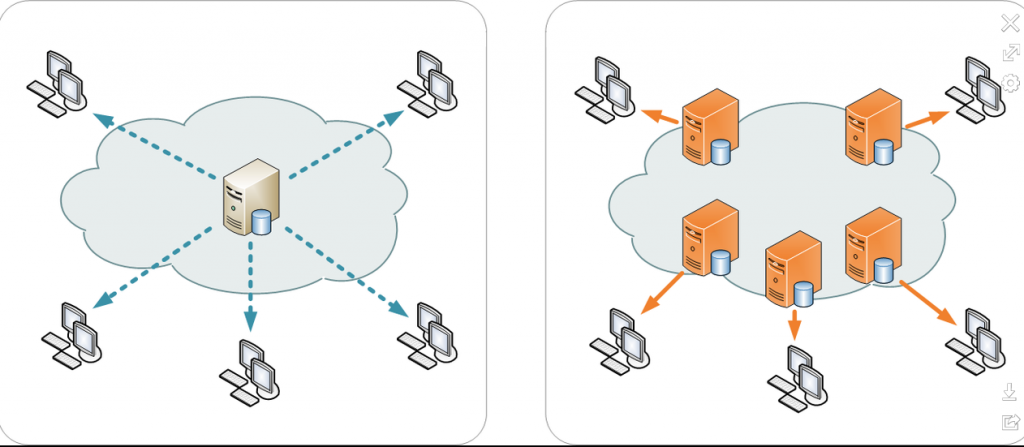
Image resource: https://en.wikipedia.org/wiki/Content_delivery_network
The information being relayed from your server to your website has less distance to travel which cuts your server response time down tremendously if you’re website is being accessed all over the world. Activating your CDN with default settings has been stated to improve site speed 10 times faster than without.
Delete unused plugins
Every plugin on your website will take up a specific amount of resources due to the code that’s written in the header. By deleting plugins you don’t need you can free up more resources by eliminating clutter in the header. Even if the plugin is deactivated, delete it if you’re not using it on your website.
Choose the right hosting plan
Depending on the resource requirements of your website, the wrong hosting plan could negatively affect your page speed. There are three options when you choose a hosting plan and each plan allows you different amounts of server resources.
Shared hosting plan
This plan is to put your website on a server that’s shared by a group of other people. Whenever people land on your website, there is a request for resources in order to load the page. If your server doesn’t have those resources available, your site will experience a delay in load time.
This can happen if too many accounts share one server. Multiple server requests made at once can overload the capacity of the server to handle every account’s needs. Even if the server has a reasonable number of accounts, if the traffic on your site grows, you may need to upgrade to the next level of hosting.
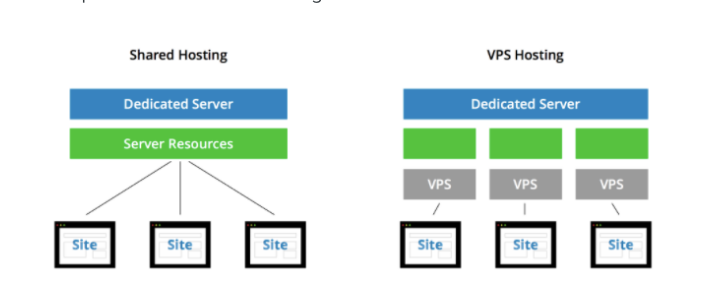
Image source: https://www.crazyegg.com/blog/speed-up-your-website/
VPS hosting account
A VPS hosting account guarantees you a specific amount of resources at any given moment. This ensures your website has the resources needs based on the expected volumes of traffic you receive.
A VPS hosting account is still a shared account, however, the number of accounts is limited in order to persevere the guaranteed allotted resources for your website.
Dedicated server
If your website experiences massive spikes in traffic you may need a dedicated server to handle the loads required to keep your site up and running. A dedicated server means there is no one else sharing your resources, which makes your server response time lightning quick.
Tools for page speed maintenance
Many of the issues that prevent fast load times can be solved without needing a degree in computer science. If there’s ever an item on your page speed report that you’re unsure about, you can always Google the problem to find a plugin that solves that issue.
Here are a few tools that can handle the majority of page speed problems and contribute to faster load times.
W3 Total Cache
This plugin can handle a few different issues in one fell swoop.
Once installed, you can configure your settings to inline and minify HTML, CSS and JavaScript by simply enabling this function in the settings.
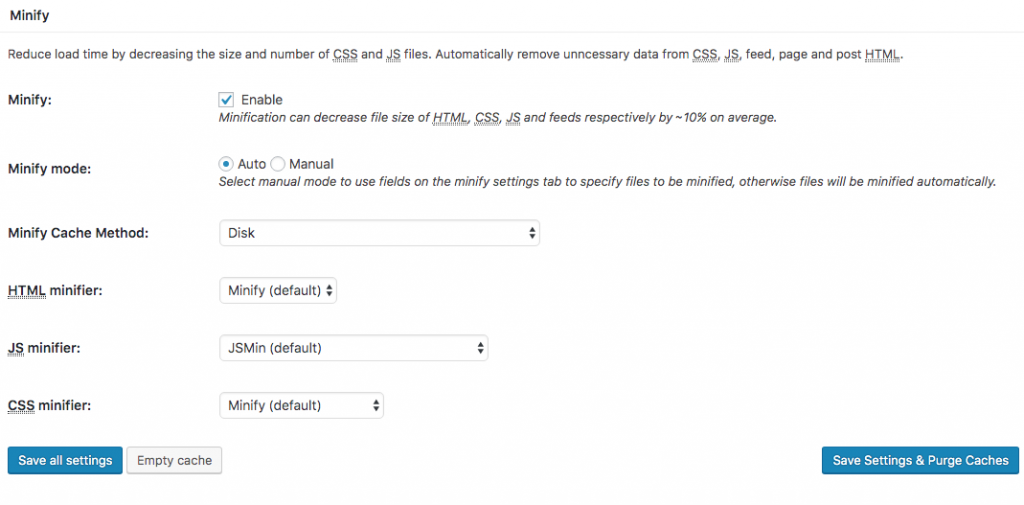
The option to leverage browser caching is also located with the settings of the plugin. Be sure to enable this option and set it to the maximum amount. of time-which is one year.
Test your website before and after installing and setting up the plugin. You’ll want to make sure you see a notable drop in your page speed. If your website doesn’t get faster, there may be a conflict between plugins that you’ll need to identify before moving forward.
Cloudflare
As a free option for using a CDN, Cloudflare is ideal. The company has an extensive network of remote servers making your website convenient to load from any region of the world. There are similar options you would find in W3 Total Cache to increase page speed.
Smush
This plugin compresses all of your images to the smallest size possible. The beauty of this plugin is that once it’s installed it will compress every image you upload automatically.
You will need to manually compress images that were uploaded prior to installing this plugin (in the free version).
Smush gives you the option to enable lazy loading to prioritize the load sequence of the images on the page.
Alternate versions of Google PageSpeed Insights
There are multiple tools for testing page speed that you can use instead of Google. Each tool has slightly different features that you may find more useful for your needs.
Sites include, but are not limited to:
- GT Metrix
- Pingdom
- YSlow
- Webpagetest.org
Incorporate page speed maintenance into your daily operations
Achieving fast page speed is not a one-time shot that is achieved overnight. Sure, you can make significant improvements with specific actions, but there are regular maintenance routines you should practice in order to maintain a website that loads quickly.
Install the plugins that best suit your business in order to automate many of the functions required for fast-loading websites. Keep in mind that just because you installed Smush doesn’t mean you can skip editing the size of your images.
Page speed is a value that fluctuates over time, and so requires a periodic evaluation. Test your pages every month to make sure there aren’t any bottlenecks building up the time it takes to load your page.
Some of the changes you need to make may be quick and apparent, while others may be more gradual and not as clear-cut. Staying on top. of the situation ensures your website pages are continually maintaining and increasing the speed at which they load.
Maintain constant vigilance of the page speed on your most important pages. The effort you put into keeping load time low will result in a landslide of benefits that ultimately increase your revenue on a regular basis.

